



DOWNLOAD PRESS RELEASE
The blockchain is widely heralded as the new internet – another dimension in an ever-faster, ever-more powerful interlocking of ideas, actions and values. Principally the blockchain is a ledger distributed across a large array of machines that enables digital ownership and exchange without a central administering body. Within the arts it has profound implications as both a means of organising and distributing material, and as a new subject and medium for artistic exploration.
This landmark publication brings together a diverse array of artists and researchers engaged with the blockchain, unpacking, critiquing and marking the arrival of it on the cultural landscape for a broad readership across the arts and humanities.
Contributors: César Escudero Andaluz, Jaya Klara Brekke, Theodoros Chiotis, Ami Clarke, Simon Denny, The Design Informatics Research Centre (Edinburgh), Max Dovey, Mat Dryhurst, Primavera De Filippi, Peter Gomes, Elias Haase, Juhee Hahm, Max Hampshire, Kimberley ter Heerdt, Holly Herndon, Helen Kaplinsky, Paul Kolling, Elli Kuru , Nikki Loef, Bjørn Magnhildøen, Rhea Myers, Martín Nadal, Rachel O Dwyer, Edward Picot, Paul Seidler, Hito Steyerl, Surfatial, Lina Theodorou, Pablo Velasco, Ben Vickers, Mark Waugh, Cecilia Wee, and Martin Zeilinger.
Read a review of the book by Regine Debatty for We Make Money Not Art
Read a review of the book by Jess Houlgrave for Medium
Gretta Louw reviews Abrahams’ book from estranger to e-stranger: Living in between languages, and finds that not only does it demonstrate a brilliant history in performance art, but, it is also a sharp and poetic critique about language and everyday culture.
Annie Abrahams is a widely acknowledged pioneer of the networked performance genre. Landmark telematic works like One the Puppet of the Other (2007), performed with Nicolas Frespech and screened live at the Centre Pompidou in Paris, or her online performance series Angry Women have solidified her position as one of the most innovative net performance artists, who looks not just at the technology itself but digs deeper to discover the ways in which it impacts human behaviour and communication. Even in the present moment, when online performativity is gaining considerable traction (consider the buzz around Amalia Ulman’s recent Instagram project, for example), Abrahams’ work feels rather unique. The strategy is one of contradiction; an intimacy or emotionality of concept and content, juxtaposed against – or, more accurately, mediated through – the technical, the digital, the screen and the network to which it is a portal. Her recent work, however, is shifting towards a more direct interpersonal and internal investigation that is to a great extent nevertheless formed by the forces of digitalisation and cultural globalisation.

(E)stranger is the title that Abrahams gave to her research project at CONA in Ljubljana, Slovenia, and which led to the subsequent exhibition, Mie Lahkoo Pomagate? (can you help me?) at Axioma. The project is an examination of the shaky, uncertain terrain of being a foreigner in a new land; the unknowingness and helplessness, when one doesn’t speak the language well or at all. Abrahams approaches this topic from an autobiographical perspective, relating this experiment – a residency about language and foreignness in Slovenia. A country with which she was not familiar and a language that she does not speak – regressing with her childhood and young adulthood experiences of suddenly being, linguistically speaking, a fish out of water. This experience took her back to when she went to high school and realised with a shock that, she spoke a dialect but not the standard Dutch of her classmates, and then this situation arose again later when she moved to France and had to learn French as a young adult.
There are emotional and psychological aspects here that are significant and poignant – and ‘extremely’ often overlooked. The way one speaks and articulates oneself is so often equated with intelligence and authority – and thus the foreigner, the newcomer, the language student, is immediately at a disadvantage in the social hierarchy and power distribution. Then, there are the emotional aspects and characteristics requisite for learning a language; one must be willing to make oneself vulnerable, to make mistakes. This is a drain on energy, strength, and confidence that is rarely if ever acknowledged in the current discourse around the EU, migration, asylum seekers, and – that dangerous word – assimilation. Abrahams lays her own experiences, struggles, and frustrations bare in a completely matter-of-fact way, prompting a re-thinking of these commonly held perceptions and exploring the ways that language pervade seemingly all aspects of thought, self, and relationships.
Of course this theme is all the more acute in a world that is increasingly dominated by if not the actual reality of a complete, coherent, and functioning network, then at least the illusion of one. In a world where, supposedly, we can all communicate with one another, there is increasing pressure to do so. Being connected, being ‘influential’ online, representing and presenting oneself online, branding, image – these are factors that are becoming virtues in and of themselves. Silicon Valley moguls like Mark Zuckerberg have spent the last five or six years carefully constructing a language in which online sharing, openness, and connectivity are aligned explicitly with morality. Just one of the many highly problematic issues that this rhetoric tries to disguise is the inherent imperialism of the entire mainstream web 2.0 movement.
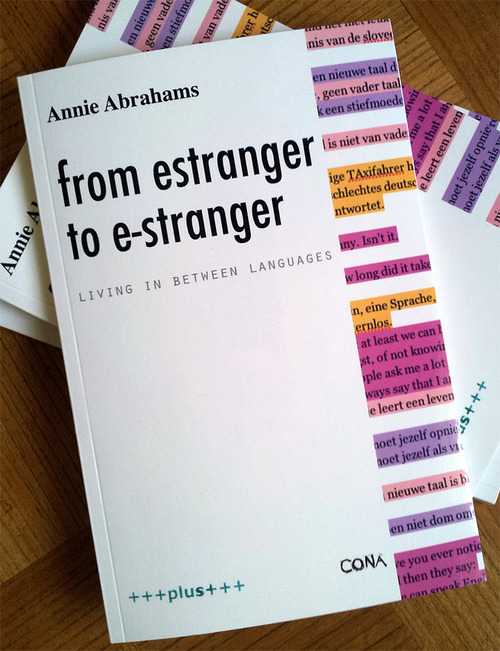
Abrahams’ book from estranger to e-stranger: Living in between languages is the analogue pendant to the blog, e-stranger.tumblr.com, that she began working on as a way to gather and present her research, thoughts, and documentation from performances and experiments during her residency at CONA in April 2014 and beyond. Her musings on, for instance, the effect dubbing films and tv programs from English into the local language, or simply screening the English original – how this seems to impact the population’s general fluency in English – raise significant questions about the globalisation of culture. And the internet is arguably even more influential than tv and cinema were/are because of the way it pervades every aspect of contemporary life.
This leads one irrevocably to consider the digital colonialism of today’s internet; the overwhelming dominance of western, northern, mainstream, urban, and mostly english-speaking people/systems/cultural and power structures. [1] Abrahams highlights the way that this bleeds into other areas of work, society, and cultural production, for example, through her citation of Mladen Stilinovic’s piece An Artist Who Cannot Speak English is No Artist (1994). In a recent blog post, Abrahams further reveals the systematic inequity of linguistic imperialism and (usually English speakers’) monolingualism, when she delves into the language politics of the EU and its diplomacy and parliament [http://e-stranger.tumblr.com/post/139842799561/europe-language-politics-policy].
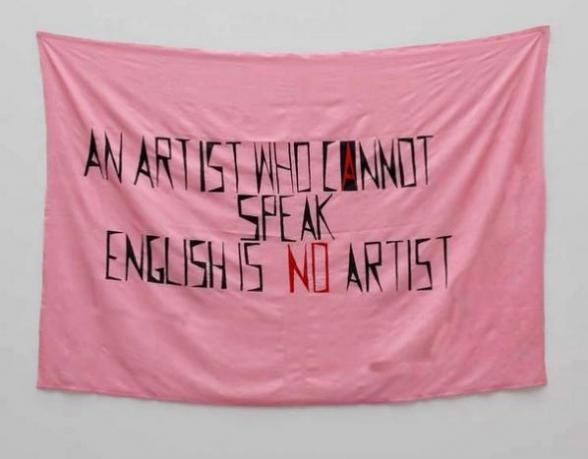
from estranger to e-stranger is an almost dadaist, associative, yet powerful interrogation of the accepted wisdoms, the supposed logic of language, and the power structures that it is routinely co-opted into enforcing. It is a consciously political act that Abrahams publishes her sometimes scattered text snippets – at turns associative or dissociative – in a wild mix of languages, still mostly English, but unfiltered, unedited, imperfect. A rebellion against the lengths to which non-native speakers are expected to go to disguise their linguistic idiosyncrasies (lest these imperfections be perceived as the result of imperfect thinking, logic, intelligence). And yet there is an ambivalence in Abrahams’ intimations about the internet that reflect the true complexity of this cultural and technological phenomena of digitalisation. Reading the book, one feels a keen criticism that is justifiably being levelled at the utopian web 2.0 rhetoric of democratisation, connection etc, but there are also moments of, perhaps, idealism, as when Abrahams asks “Is the internet my mother of tongues? a place where we are all nomads, where being a stranger to the other is the status quo.”
Abrahams’ project is timely, especially now that we are all (supposedly) living in an infinitely connected, post-cultural/post-national, online society, we are literally “living between languages”. The book is an excellent resource, because it is not a coherent, textual presentation of a thesis; of one way of thinking. It is, like the true face of the internet, a collection, a sample, of various thoughts, opinions, ideas, and examples from the past. One can read from estranger to e-stranger cover to cover, but even better is to dip in and out, and or to follow the links and different pages present, and be diverted to read another text that is mentioned, to return, to have an inspiration of one’s own and to follow that. But to keep coming back. There is more than enough food for thought here to sustain repeated readings.
Charlie Gere is a Media Theory and History professor in the Lancaster Institute for Contemporary Arts, Lancaster University. Co-curator of FutureEverybody, the 2012 FutureEverything exhibition in Manchester. In 2007 he co-curated Feedback, a major exhibition on art responsive to instructions, input, or its environment, in Gijon, Northern Spain. He has given talks at many major arts institutions, including the Centre de Cultura Contemporània de Barcelona, the Architectural League in New York, Tate Britain, and Tate Modern. Gere’s new book, Community without Community in Digital Culture (Palgrave MacMillan, 2012), is out now.
Previous titles include: Digital Culture (Reaktion Books, 2002), Art, Time and Technology (Berg, 2006), Non-relational Aesthetics, with Michael Corris (Artwords, 2009). Gere was co-editor of White Heat Cold Logic (MIT Press, 2009), and Art Practice in a Digital Culture (Ashgate, 2010), as well as writing many papers on questions of technology, media and art. He is also co-editing with Robin Boast an anthology entitled Allegories of the Information Age (forthcoming).
Marc Garrett: Digital Culture was originally published in 2002, which happens to be the version I’ve had all these years. In 2008 it was republished, revised and expanded. Now the book has an extra chapter ‘Digital Culture in the Twenty-first Century’. Of course, we already know that digital technology and society has changed dramatically since 2002. So, what themes and historical contexts did you choose, as necessary to include in this new and last chapter?
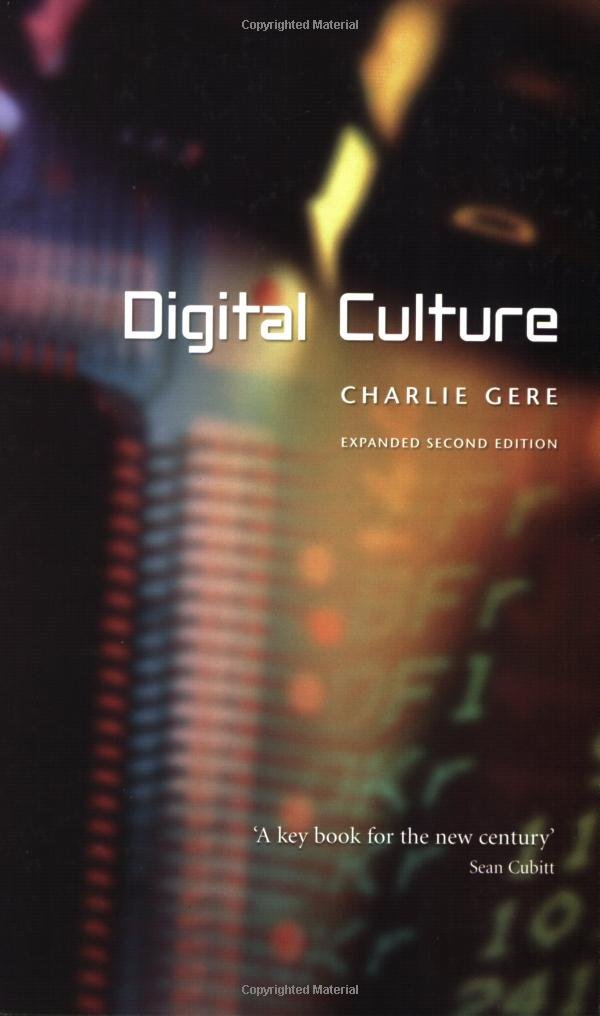
Charlie Gere: What happened after the first edition’s publication was of course, the rise of so-called Web 2:0, which was simply the greater exploitation of the reciprocal possibilities of the Web. I tried to reflect on how this reciprocity was visible beyond the Web itself and was becoming part of a more general culture of engagement and exchange, not that I share some of the more utopian visions of this phenomenon. Indeed, in my new book Community without Community in Digital Culture, I try to counter the, for me, more naive visions of community in relation to digital technology. I advocate a more ‘non-relational’ approach that does not deny the transformative effects of new media in terms of community but thinks of it more in terms of hospitality to the other.
MG: Many of the artists we have worked with are using new media to explore and critique the utopian assumptions you discuss: YOHA, IOCOSE, Liz Sterry, M.I.G (Men In Grey, Julian Oliver and Danja Vasiliev), Heath Bunting, Face to facebook (Paolo Cirio and Alessandro Ludovico), Annie Abrahams and more. Each of them work in a deeply relational way to intervene in the mythologies projected about digital technology; and, with a knowingly crtical eye of the technical limitations and the social controls at work when using networked technology. At different levels, all are producing work that ‘consciously’ incoporate relational contexts, in some way or another, this includes ideas and approaches with autonomy as part of their art, but not necessarily advocating technology as a singular, saving grace.
How do you view the role of this practice in the context of the wider corporate and state impact on the way technical cultures are evolving. How do you see the notion of hospitality working between the arts and these other more mainstream cultures?
CG: I greatly admire and like the work of the artists you mention and others doing similar things. For me they exemplify the complexity of the idea of hospitality. In general the Web is about exchange, whether that of money for goods, social links and relational exchanges in social networks, or the exchange of speech and dialogue in on-line fora. The work of these artists refuses this demand for exchange and profit within a restricted economy. Thus they are in a sense parasitical on the Web. The word ‘parasite’ comes from ‘para sitos’, meaning ‘beside the grain’, and refers to those animals that take advantage of grain stores to feed. They are the creatures to who must be offered hospitality, as a gift, without expectation of return, which means that while they are bound up with the technological systems that comprise the Web, they are not part of the restricted economy of exchange, profit, and return that is at the heart of capitalism, and to which everything else ends up being subordinated and subsumed. Thus they find an enclave away from total subsumption not outside of the market, but at its technical core.
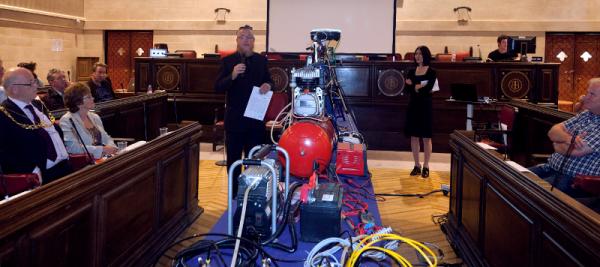

MG: Many are aware that technology and digital culture have changed the world we live in and appreciate their immediate effects on our everyday behaviours and situations. But there is a bigger story to tell, and history can offer us insightful glimpses, important clues and ways into this story about our relationship with technology and digital culture. One of the arguments outlined in your book ‘Digital Culture’ is that digital culture is neither radical, new nor technologically driven. With this in mind, which past developments do we need to acknowledge and be reminded of and why?
CG: For me the emergence of digital technology is part of a much longer story of abstraction, codification, quantification and mathematisation that can be traced back to numerous points in the history of the West, from Ancient Greece, to early Modernity to the rise of industrial capitalism. Here one might think of Heidegger’s use of ‘cybernetics’, a word we normally associate with post-war computing culture, to describe the technology and calculative enframing of modern society which he traces back to the Ancient Greeks and especially to Plato. I am not a particular advocate of digital technology, and while I appreciate its uses, I also think we must try to be aware of how it determines the way in which we think, and in which we conceive of the world. Above all we should not regard it as merely a conduit to an uncomplicated world simply out there, but rather the means by which a particular world comes to be for us. That said, this is very hard, given that in my view, and to adapt a well-known phrase from Derrida, il n’y a pas de hors-media, there’s no Archimedean point outside of our medial condition, from which we can understand it as from a god’s eye view. ‘Media determine our situation’ as Friedrich Kittler put it.
MG: In Digital Culture, you write about the composer John Cage and how he “has had the most profound influence on our digital culture”, and how his influence has opened up various different avenues of creative engagement. And, many of his ideas on interactivity and multi-media not only “have repercussions in the art world”, but also a strong influence on how computers are used as a medium. Which art movements in particular did he influence and what kind of legacy did he leave for others in relation to computers?
CG: Actually Cage’s influence on those using computers in the arts is probably less to do with what he himself did with such technology and more to do with his use of aleatory methods in many his different projects across many artforms. Also there is something about Cage’s own refusal of a normative Western subjectivity that is also consonant with aspects of our hyper-technologised existence with its emphasis on decentering the individual. Both the refusal of such subjectivity and the aleatory work together to produce a new model of the artist as conduit of contingent social forces rather than protean demi-urge or genius.
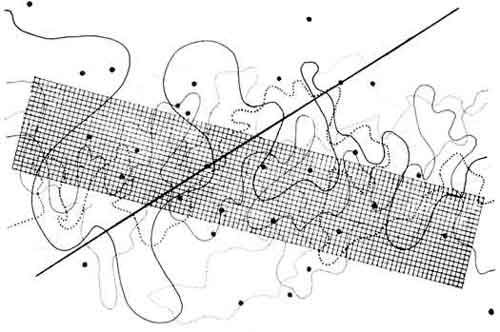
MG: Your new book ‘Community without Community in Digital Culture’, has come out at the same time as Geert Lovink’s ‘Networks Without A Cause: A critique of Social Media’. Lovink asks “How do we overcome this paradoxical era of hyped-up individualization that results precisely in the algorithmic outsourcing of the self? How do we determine significance outside of the celebrity paradigm and instead use intelligence to identify what’s at stake?” [1]
Where are your thoughts in regard to Lovink’s question, and does it relate to what you propose in terms of “hospitality to the other?”
CG: I haven’t read Geert’s book, yet at least… But I am highly sympathetic to what I take to be his position. My view is that the Web is part of a broader set of developments that apparently concern relationally, but actually emphasize the sovereign individual and autonomous subject of modernity, as well as promoting spectacular and image-bound forms of presentation and relation. The problem is that one alternative to this individualization is a kind of fascistic identification with the mass, in the form of fusion that negates the individual. A solution maybe to engage with the idea of the other in terms of difference, as both relational and separate, and yet also that which we depend on for our identity in a process of differentiation; thus the idea of hospitality as a reception of the other in difference.
MG: Community without Community in Digital Culture, is a curious title. It proposes contradictory meanings and these contradictions are clearly explained in the introduction. Although, the last sentence says “In this such technologies are part of the history of the death of God, the loss of an overarching metaphysical framework which would bind us together in some form of relation or communion. This can be understood in terms of contingency, which has the same root as contact.”
Could you unpack this last sentence for us, I’m especially interested in what contingency means to you?
CG: I owe my understanding of contingency to the work of philosopher Quentin Meillassoux, whose book After Finitude is causing a stir. Meillassoux is one of a small number of young philosophers sometimes grouped together under the name ‘speculative realism’, mostly because of their shared hostility to what they call ‘Kantian correlationism’, the idea that there can be no subject-independent knowledge of objects. Meillassoux follows the work of David Hume, who questioned the whole notion of causation; how one can demonstrate that, all things being equal, one thing will also cause another. For Hume causation is a question of inductive reasoning, in that we can posit causation on the grounds of previous experience. Meillassoux pushes the implications of Hume’s critique of causation to a point beyond Hume’s own solution, to propose the only necessity is that of contingency, and that everything could be otherwise, or what Meillassoux calls ‘hyperchaos’.
![Community without Community in Digital Culture [Hardcover]. Dr Charlie Gere. Palgrave Macmillan (2012) http://www.barnesandnoble.com/w/community-without-community-in-digital-culture-charlie-gere/1110025572 See on Amazon.](http://www.furtherfield.org/wp-content/uploads/2012/09/179510500.jpg)
I use his ideas to think through the implications of the ‘digital’. According to the Oxford English Dictionary ‘digital’ has a number of meanings, including ‘[O]f, pertaining to, using or being a digit’, meaning one of the ‘ten Arabic numerals from 0 to 9, especially when part of a number’, and also ‘designating a computer which operates on date in the form of digits or similar discrete data… Designating or pertaining to a recording in which the original signal is represented by the spacing between pulses rather than by a wave, to make it less susceptible to degradation’ (the word for data in the form of a wave being ‘analog’).
As well as referring to discrete data the dictionary also defines ‘digital’ as ‘[O]f or pertaining to a finger or fingers’ and [R]esembling a finger or the hollow impression made by one’, thus by extension the hand, grasping, touching and so on. Much of the book concerns deconstructing the ‘haptocentric’ implications of contact, and communication, especially in relation to the claims made for social networks, and to engage with what I understand as the relation between ‘contact’ and contingency’. ‘Contingency’ is derived from the Latin con + tangere, to touch. ‘Contingency’ enables us think through the implications of the term digital, by acknowledging both its relation to the hand and touch and also to the openness and blindness to the future that is a concomitant part of our digital culture after the death of God.
MG: What other subjects can we expect to read about in the publication?
CG: Touch in Aristotle and medieval theology, cave painting, mail art, Darwin and Dawkins, Luther Blissett, On Kawara, Frank Stella, Bartleby the Scrivener, Christianity – among other things… oh, and a lot of Derrida.
MG: If there is a message you’d like to send to the world, as it carries on regardless with its “permanent exposure of life, of all lives, to ‘all-out’ control […] thanks to computer technology” [2] (Virilio 2000), and it was printed on a banner, or on a billboard in the streets, what would it be?
I am reading Blanchot at the moment, so perhaps something like ‘the disaster has already happened’ (it’s suitably enigmatic to annoy people).
<———————————- The End (for now) ——————————>
White Heat Cold Logic
British Computer Art 1960-1980
Edited by Pal Brown, Charlie Gere, Nicholas Lambert and Catherine Mason
ISBN 9780262026536
MIT Press 2008
This is the third and last in a series of reviews of the results of the CACHe project. The first review was of the V&A’s show and book “Digital Pioneers“, the second was of Catherine Mason’s “A Computer In The Art Room”. Where “A Computer In The Art Room” concentrated on the history of art computing in British educational institutions up to 1980, “White Heat Cold Logic” gives voice to the individuals who made art using computers in that period more generally.
Charlie Gere’s introduction explains the source of the book’s title, referring to the British Prime Minister Harold Wilson’s famous 1963 speech that a new Britain would be forged in the white heat of the scientific and technological revolution. Gere provides an overview of the history of art computing in the era that may be familiar from “A Computer In The Art Room” which is much needed, for it provides useful context for what follows in this volume. He also argues for the value and interest of the history of art computing, in terms that make it clear for academia.

Roy Ascott describes the emergence of pre-computational art informed by cybernetics, systems theory and process against the background of the emergence of “Grounds Course” art education. Adrian Glew documents Stephen Willats’ use of computing in the processes of his art of cybernetic social engagement, the first but not the last more mainstream British artist to appear. John Hamilton Frazer describes the unrealised interactive architecture of the 1960s “Fun Palace” and 1980s “Generator” and of the technology and social legacies of these nonetheless influential projects.
Maria Fernandez puts the figure of Gordon Pask centre stage. As John Lansdown (to whom this book is dedicated) emerged as a major figure behind educational arts computing in “A Computer In The Art Room”. Gordon Pask also emerges in this volume as the cybernetic prophet of the 1960s, mentioned by many in the early essays in this book. His own interactive theatre and robotic mobiles complement his involvement in planning the Fun Palace and as a source of ideas and support for more projects.
Jasia Reichardt provides a theoretical and practical insight into the genesis of her foundational “Cybernetic Serendipity” show at the ICA in 1968 and considers what came next. Brent Macgregor provides an outside view of the same. Neither attempts to mythologize this much mythologized show, the reality of its achievements is more than impressive enough.
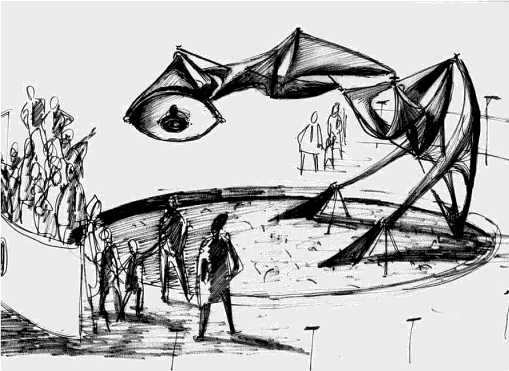
Edward Ihnatowicz is the subject of two essays, one with tantalising images of preparatory and documentary material by Aleksandar Zivanovic and an insightful but more personal essay by Richard Ihnatowicz. Hopefully his reputation will continue to increase towards the level it deserves.
Richard Wright follows the ideas of Constructivist art into Systems Theory, which alongside cybernetics is one of the guiding ideas of the art of the period overdue for rediscovery both within art computing and more generally.
Harold Cohen remembers the origins of his “AARON” painting program in a tale of the struggle of art against bureaucracy. Tony Logson’s tale is surprisingly similar, although his systems-based art is very different from Cohen’s cognitively-inspired forms. Simon Ford reveals Gustav Metzger’s involvement with early computer art and with the Computer Arts Society (CAS). CAS also feature large in Alan Sutcliffe’s description of his computer music compositions, one of many essays that left me wishing I could see the code and experience the art as well as reading about it.
George Mallen also touches on CAS, and on Pask’s System Research Ltd. as he explains the art and business of the production of the unprecedented environmentalist interactive multimedia of the “Ecogame”. The Ecogame is one of many works in the book that people simply need to know about. Doron D. Swade makes the idea of the “two cultures” of art and technology that came together for the Ecogame more explicit in an attempt to recover the art of the Science Museum’s first computing exhibit.

Malcolm le Grice and Stan Heyward each describe the institutional travails of making some of the first computer animation in the UK. Catherine Mason draws together the history of many of the institutions already mentioned in what is both a recap and an extension of the history she presented in “A Computer In the Art Room”. Stephen Bury and Paul Brown bring the influence of the Slade to the fore in their chapters, revealing the Slade as an important piece in the puzzle of British Computer Art.
Stephen Scrivener, Stephen Bell, Ernest Edmonds and Jeremy Gardiner each describe their personal artistic journeys through the era of FORTRAN and flatbed plotting, illustrated by images of their work that again made me wish I could also see the code. Graham Howard describes how conceptual artists Art & Language didn’t use a university computer to generate the 64,000 permutations of one of their “Index” projects of the 1970s, instead gaining access to a local produce distribution company’s mainframe across several weekends.
The different strands of technology, institutions, ideas and economics are all drawn together in John Vince’s history of the PICASO graphics library, which spread from Middlesex Polytechnic to many other educational institutions and the successor to which, PRISM, was used to make the first logo for Channel 4.
Brian Reffin Smith makes clear, artists were as affected by the idea of computing as by computers themselves, especially when they didn’t have access to them. The Fun Palace was influential despite never being realized, Senster was influential despite being lost. It is important to realize just how limited access to computing machinery was in the era covered by the book, and to recognize how ideas of computing and its potential were part of the broader intellectual environment of the time.
Finally, Beryl Graham’s postscript covers the history of UK arts computing after 1980. I lived through some of the period covered and I recognise Graham’s description of it. The critical irony that she identifies in UK net.art and interactive multimedia is of key importance to its art historical value. Although I would question how uniquely British this is, the UK certainly took it as a baseline. As with Gere’s introduction, Graham presents the case for art computing in a way that the art critical mainstream should not just be able to understand but should be inspired by. Cybernetics, systems theory, environmentalism, socialisation, the content of conceptual art, and the political concerns and developments of the Cold War all illuminate and are in turn illuminated by this history.
For a book about art computing it is frustrating how little art and source code is illustrated in the book. Much work has been lost of course, and “Digital Pioneers” does illustrate art from this period. But for preservation, criticism and artistic progress (and I do mean progress) it is vital that as much code as possible is found and published under a Free Software licence (the GPL). Students of art computing can learn a lot from the history of their medium despite the rate at which the hardware and software used to create it may change, and code is an important part of that.
White Heat, Cold Logic presents hard-won knowledge to be learnt from and built on, achievements to be recognised, and art to be appreciated. Often from the people who actually made it. What was previously the secret history or parallel universe of art computing can now be seen in context alongside the other avant-garde art movements of the mid-late 20th century. I cannot over-emphasise the service that CACHe has done the art computing community and the arts more generally by providing this much needed reappraisal of early arts computing in the UK.
The text of this review is licenced under the Creative Commons BY-SA 3.0 Licence.
Featured image: Remixthebook Cover
“For us, art is not an end in itself … but it is an
opportunity for the true perception and criticism
of the times we live in.” Hugo Ball.
The challenge in trying to review a book like Mark Amerika’s Remixthebook, is the feeling you can only do justice to the text by doing the same with your review. The apparent simplicity coupled with the multifarious outcomes are intoxicating. You could be mistaken for believing that every possible remix would produce fresh and exciting outcomes. The key of course, is to have good source material in the first place. Also, to have developed a keen eye for what blends and meshes together and what doesn’t. Even the most disparate work requires judgment and prior awareness. Remixthebook asks us to consider the idea of remixology as part of the work of modern artists. The tone and style of the book is a blend of ideas, voices and thoughts with a myriad of concepts, which attempts be the very embodiment of the ideas it espouses.
Amerika explores various precedents for the remixological concept and draws on some known practitioners from the past: amongst them, Allen Ginsberg, William S. Burroughs and Brion Gysin. He explores existing ideas and welds them into his own armoury. Their ideas considered as part of his own creative practice, brought back to the now with new life, in our contemporary networked culture.
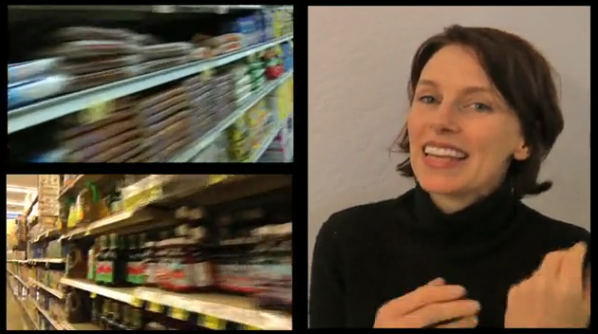
Other than just being a systematic breakdown of the different types of remixing and their potential outputs (or artifacts, as they might be better known in an art critical framework?) Amerika considers the pathways and theoretical underpinnings of remix culture. Having taken this beyond his own practice of the written word and web-based projects, he considers his recent and ongoing VJ work. Blending and collage-making with images during live music performances suggests some of the instinctive, instantaneous ideas that come out of a lifetime’s collecting, collating and absorbing of diverse imagery, words and cultural concepts. It’s within this process that he believes more novel outcomes can arise, against the constant flux of media creation and dissemination. It is the ‘becoming’ of the media artist that is revealed in the live remixing performance.
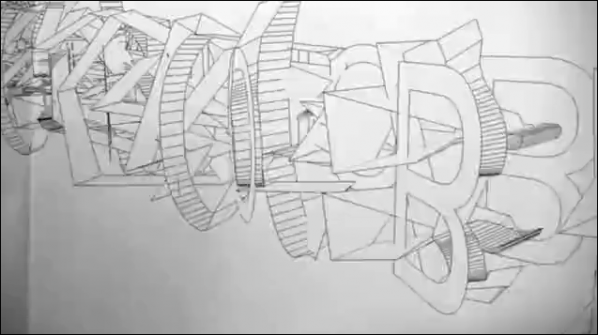
Reflecting on this process of cultural assimilation Mark Amerika, situates remixology within a wider creative output and theoretical framework. This involves a cross hybrid of everyday, mainstream references with high art and ‘high’ theory, all written in his at once complex and convoluted, yet easily read and enjoyable writing style. But like remixology, what looks simple is the result of deep reading and heavy conceptual thinking. This isn’t to say that you won’t have trouble decoding the writing and getting to the heart of his thinking, but it helps if you spend time with the text and allow the rhythms and structures to become second nature to you. Close reading allows the text to fall into place. For example, consider the following extract from the section eros intensification:
Here is where we enter the realm of
what I have been calling intersubjective jamming
which is different than the idea of a Networked Author
or Collaborative Groupthink Mentality that preys
on the lifestyles of the Source Material Rich
and seemingly forever Almost Famous.
It is worth remembering that Mark Amerika is a creative writer first and foremost. He uses theory as a palette from which to draw out ideas and situations for further reflection and to help give some context to the point he is trying to make. The text of remixthebook is an example of his creative practice in action, as much as it is a personal reflection on his attempts to develop a thought process for it. Theory becomes entwined in critical reflection and creative output. You don’t necessarily come to remixthebook for philosophical answers and hard academic points of view, instead you ride the maelstrom of thoughts and conceptualizing to gain a better handle on a way of considering artistic practice.
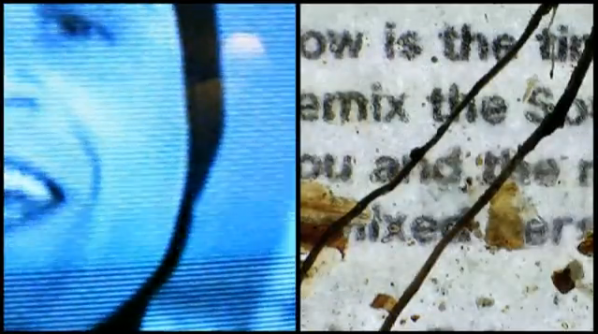
The website of the book (probably a ubiquitous extra for any media art-related publication these days) follows a natural path of inclusion and invites artists to take sections of the book and remix them according to their own aesthetic and remixological preferences. While some of the work brings in extra visuals and places itself in a flowing context of media streams, allowing different work to become part of the project, Rick Silva’s The Isarithm sources Amerika’s Sentences on Remixology 1.0 and explodes them out of the screen and into a layered and playful vortex of shapes and lines.
Will Leurs uses some captured footage taken directly off the tv screen for A Pixel and Glitch Hotel Room and combines it with some source material supplied by Amerika from several ‘lectures’ he has supplied. These lectures appear within several other contributors work as well. The point of some of these remixes and the varied forms they take (the collection includes some purely audio work) is that, as well as being interesting works themselves, they are exemplars and guides to even further potentials of the remixological principle.
Mark Amerika’s Remixthebook at times may leave you looking beyond it to the appendix or for any footnotes that would fill out spaces or help make conceptual leaps for you. That isn’t the point of the book. The idea is to take the book as a starting point and expand on your own creative process. Possibly the best approach is to literally cut-up the book and try some experimentation of your own, Brion Gysin style. Flex the covers back and pull out the pages. Through destruction and reconfiguration, the book might be bent to your will and become something that you can use. Perhaps the sight of a ripped and destroyed book would strike horror into some authors. I can’t help thinking that Mark Amerika would take great joy in the image and say that he’d planned it all along.
The remixthebook.com website
http://www.remixthebook.com
The remixthebook Blog
http://www.remixthebook.com/theblog
Remixology by OpenMedia.ca – a national, non-partisan, non-profit organization working to advance and support an open and innovative communications system in Canada.
http://openmedia.ca/remixology
Society of the Spectale (A Digital Remix)
By Mark Amerika On August 16, 2011.
http://www.remixthebook.com/society-of-the-spectale-a-digital-remix
REMIXTAPE 2.0 //
Remixology is a music blog based in Paris (France) devoted to remixes friendly music.
http://remixology.tumblr.com/
REFF- Remix the world! Reinvent reality! exhibition at Furtherfield Gallery between 25 February and 26 March 2011. http://www.furtherfield.org/exhibitions/reff-remix-world-reinvent-reality
Visitorsstudio – an online place for real-time, multi-user mixing, remixing, collaborative creation, many to many dialogue and networked performance and play.
http://www.visitorsstudio.org/x.html
Brion Gysin. Essays & Stories, Interviews, Excerpts & Publications
http://briongysin.com
“At the dawn of the new millennium, Net users are developing a much more efficient and enjoyable way of working together: cyber-communism.” Richard Barbrook.
Dmytri Kleiner, author of The Telekommunist Manifesto, is a software developer who has been working on projects “that investigate the political economy of the Internet, and the ideal of workers’ self-organization of production as a form of class struggle.” Born in the USSR, Dmytri grew up in Toronto and now lives in Berlin. He is a founder of the Telekommunisten Collective, which provides Internet and telephone services, as well as undertakes artistic projects that explore the way communication technologies have social relations embedded within them, such as deadSwap (2009) and Thimbl (2010).
“Furtherfield recently received a hard copy of The Telekommunist Manifesto in the post. After reading the manifesto, it was obvious that it was pushing the debate further regarding networked, commons-based and collaborative endeavours. It is a call to action, challenging our social behaviours and how we work with property and the means of its production. Proposing alternative routes beyond the creative commons, and top-down forms of capitalism (networked and physical), with a Copyfarleft attitude and the Telekommunist’s own collective form of Venture Communism. Many digital art collectives are trying to find ways to maintain their ethical intentions in a world where so many are easily diverted by the powers that be, perhaps this conversation will offer some glimpse of how we can proceed with some sense of shared honour, in the maelstrom we call life…”
Marc Garrett: Why did you decide to create a hard copy of the Manifesto, and have it republished and distributed through the Institute of Networked Cultures, based in Amsterdam?
Dmytri Kleiner: Geert Lovink contacted me and offered to publish it, I accepted the offer. I find it quite convenient to read longer texts as physical copies.
MG: Who is the Manifesto written for?
DK: I consider my peers to be politically minded hackers and artists, especially artists whose work is engaged with technology and network cultures. Much of the themes and ideas in the Manifesto are derived from ongoing conversations in this community, and the Manifesto is a contribution to this dialogue.
MG: Since the Internet we have witnessed the rise of various networked communities who have explored individual and shared expressions. Many are linked, in opposition to the controlling mass systems put in place by corporations such as Facebook and MySpace. It is obvious that your shared venture critiques the hegemonies influencing our behaviours through the networked construct, via neoliberal appropriation, and its ever expansive surveillance strategies. In the Manifesto you say “In order to change society we must actively expand the scope of our commons, so that our independent communities of peers can be materially sustained and can resist the encroachments of capitalism.” What kind of alternatives do you see as ‘materially sustainable’?
DK: Currently none. Precisely because we only have immaterial wealth in common, and therefore the surplus value created as a result of the new platforms and relationships will always be captured by those who own scarce resources, either because they are physically scarce, or because they have been made scarce by laws such as those protecting patents and trademarks. To become sustainable, networked communities must possess a commons that includes the assets required for the material upkeep of themselves and their networks. Thus we must expand the scope of the commons to include such assets.
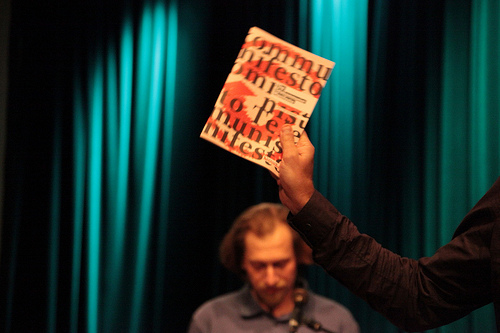
MG: The Manifesto re-opens the debate around the importance of class, and says “The condition of the working class in society is largely one of powerlessness and poverty; the condition of the working class on the Internet is no different.” Could you offer some examples of who this working class is using the Internet?
DK: I have a very classic notion of working class: Anyone whose livelihood depends on their continuing to work. Class is a relationship. Workers are a class who lack the independent means of production required for their own subsistence, and thus require wage, patronage or charity to survive.
MG: For personal and social reasons, I wish for the working class not to be simply presumed as marginalised or economically disadvantaged, but also engaged in situations of empowerment individually and collectively.
DK: Sure, the working class is a broad range of people. What they hold in common is a lack of significant ownership of productive assets. As a class, they are not able to accumulate surplus value. As you can see, there is little novelty in my notion of class.
MG: Engels reminded scholars of Marx after his death that, “All history must be studied afresh”[1]. Which working class individuals or groups do you see out there escaping from such classifications, in contemporary and networked culture?
DK: Individuals can always rise above their class. Many a dotCom founder have cashed-in with a multi-million-dollar “exit,” as have propertyless individuals in other fields. Broad class mobility has only gotten less likely. If you where born poor today you are less likely than ever to avoid dying poor, or avoid leaving your own children in poverty. That is the global condition.
I do not believe that class conditions can be escaped unless class is abolished. Even though it is possible to convince people that class conditions do not apply anymore by means of equivocation, and this is a common tactic of right wing political groups to degrade class consciousness. However, class conditions are a relationship. The power of classes varies over time, under differing historical conditions.
The condition of a class is the balance of its struggle against other classes. This balance is determined by its capacity for struggle. The commons is a component of our capacity, especially when it replaces assets we would otherwise have to pay Capitalist-owners for. If we can shift production from propriety productive assets to commons-based ones, we will also shift the balance of power among the classes, and thus will not escape, but rather change, our class conditions. But this shift is proportional to the economic value of the assets, thus this shift requires expanding the commons to include assets that have economic value, in other words, scarce assets that can capture rent.
MG: The Telekommunist Manifesto, proposes ‘Venture Communism’ as a new working model for peer production, saying that it “provides a structure for independent producers to share a common stock of productive assets, allowing forms of production formerly associated exclusively with the creation of immaterial value, such as free software, to be extended to the material sphere.” Apart from the obvious language of appropriation, from ‘Venture Capitalism’ to ‘Venture Communism’. How did this idea come about?
DK: The appropriation of the term is where it started.
The idea came about from the realization that everything we were doing in the free culture, free software & free networks communities was sustainable only when it served the interests of Capital, and thus didn’t have the emancipatory potential that myself and others saw in it. Capitalist financing meant that only capital could remain free, so free software was growing, but free culture was subject to a war on sharing and reuse, and free networks gave way to centralized platforms, censorship and surveillance. When I realized that this was due to the logic of profit capture, and precondition of Capital, I realized that an alternative was needed, a means of financing compatible with the emancipatory ideals that free communication held to me, a way of building communicative
infrastructure that was born and could remain free. I called this idea Venture Communism and set out to try to understand how it might work.
MG: An effective vehicle for the revolutionary workers’ struggle. There is also the proposition of a ‘Venture Commune’, as a firm. How would this work?
DK: The venture commune would work like a venture capital fund, financing commons-based ventures. The role of the commune is to allocate scarce property just like a network distributes immaterial property. It acquires funds by issuing securitized debt, like bonds, and acquires productive assets, making them available for rent to the enterprises it owns. The workers of the enterprises are themselves owners of the commune, and the collected rent is split evenly among them, this is in addition to whatever remuneration they receive for work with the enterprises.
This is just a sketch, and I don’t claim that the Venture Communist model is finished, or that even the ideas that I have about it now are final, it is an ongoing project and to the degree that it has any future, it will certainly evolve as it encounters reality, not to mention other people’s ideas and innovations.
The central point is that such a model is needed, the implementation details that I propose are… well, proposals.
MG: So, with the combination of free software, free code, Copyleft and Copyfarleft licenses, through peer production, does the collective or co-operative have ownership, like shares in a company?
DK: The model I currently support is that a commune owns many enterprises, each independent, so the commune would own 100% of the shares in each enterprise. The workers of the enterprises would themselves own the commune, so there would be shares in the commune, and each owner would have exactly one.
MG: In the Manifesto, there is a section titled ‘THE CREATIVE ANTI-COMMONS’, where the Creative Commons is discussed as an anti-commons, peddling a “capitalist logic of privatization under a deliberately misleading name.” To many, this is a controversy touching the very nature of many networked behaviours, whether they be liberal or radical minded. I am intrigued by the use of the word ‘privatization’. Many (including myself) assume it to mean a process whereby a non-profit organization is changed into a private venture, usually by governments, adding extra revenue to their own national budget through the dismantling of commonly used public services. Would you say that the Creative Commons, is acting in the same way but as an Internet based, networked corporation?
DK: As significant parts of the Manifesto is a remix of my previous texts, this phrase originally comes from the longer article “COPYRIGHT, COPYLEFT AND THE CREATIVE ANTI-COMMONS,” written by me and Joanne Richardson under the name “Ana Nimus”:
http://subsol.c3.hu/subsol_2/contributors0/nimustext.html
What we mean here is that the creative “commons” is privatized because the copyright is retained by the author, and only (in most cases) offered to the community under non-commercial terms. The original author has special rights while commons users have limited rights, specifically limited in such a way as to eliminate any possibility for them to make a living by employing this work. Thus these are not commons works, but rather private works. Only the original author has the right to employ the work commercially.
All previous conceptions of an intellectual or cultural commons, including anti-copyright and pre-copyright culture as well as the principles of free software movement where predicated on the concept of not allowing special rights for an original author, but rather insisting on the right for all to use and reuse in common. The non-commercial licenses represent a privatization of the idea of the commons and a reintroduction of the concept of a uniquely original artist with special private rights.
Further, as I consider all expressions to be extensions of previous perceptions, the “original” ideas that rights are being claimed on in this way are not original, but rather appropriated by the rights-claimed made by creative-commons licensers. More than just privatizing the concept and composition of the modern cultural commons, by asserting a unique author, the creative commons colonizes our common culture by asserting unique authorship over a growing body of works, actually expanding the scope of private culture rather than commons culture.
MG: So, this now brings us to Thimbl, a free, open source, distributed micro-blogging platform, which as you say is “similar to Twitter or identi.ca. However, Thimbl is a specialized web-based client for a User Information protocol called Finger. The Finger Protocol was orginally developed in the 1970s, and as such, is already supported by all existing server platforms.” Why create Thimbl? What kind of individuals and groups do you expect to use it, and how?
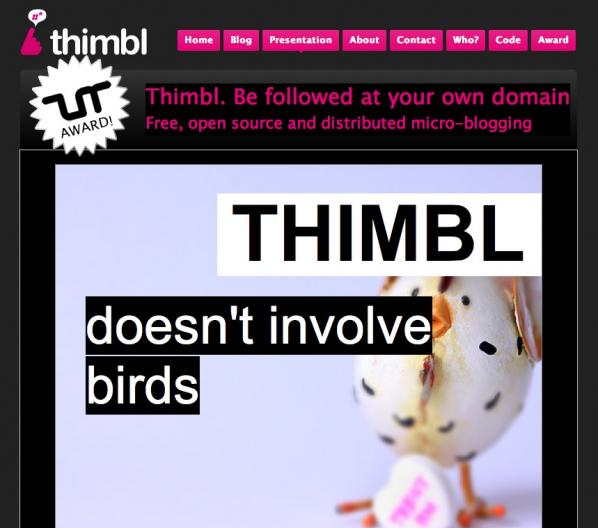
DK: First and foremost Thimbl is an artwork.
A central theme of Telekommunisten is that Capital will not fund free, distributed platforms, and instead funds centralized, privately owned platforms. Thimbl is in part a parody of supposedly innovative new technologies like twitter. By creating a twitter-like platform using Finger, Thimbl demonstrates that “status updates” where part of network culture back to the 1970s, and thus multimillion-dollar capital investment and massive central data centers are not required to enable such forms of communication, but rather are required to centrally control and profit from them.
MG: In a collaborative essay with Brian Wyrick, published on Mute Magazine ‘InfoEnclosure-2.0’, you both say “The mission of Web 2.0 is to destroy the P2P aspect of the Internet. To make you, your computer, and your Internet connection dependent on connecting to a centralised service that controls your ability to communicate. Web 2.0 is the ruin of free, peer-to-peer systems and the return of monolithic ‘online services’.”[2] Is Thimbl an example of the type of platform that will help to free-up things, in respect of domination by Web 2.0 corporations?
DK: Yes, Thimbl is not only a parody, it suggests a viable way forward, extending classic Internet platforms instead of engineering overly complex “full-stack” web applications. However, we also comment on why this road is not more commonly taken, because “The most significant challenge is not technical, it is political.” Our ability to sustain ourselves as developers requires us to serve our employers, who are more often than not funded by Capital and therefore are primarily interested in controlling user data and interaction, since delivering such control is a precondition of receiving capital in the first place.
If Thimbl is to become a viable platform, it will need to be adopted by a large community. Our small collective can only take the project so far. We are happy to advise any who are interested in how to join in. http://thimbl.tk is our own thimbl instance, it “knows” about most users I would imagine, since I personally follow all existing Thimbl users, as far as I know, thus you can see the state of the thimblsphere in the global timeline.
Even if the development of a platform like Thimbl is not terribly significant (with so much to accomplish so quickly), the value of a social platform is the of course derived from the size of it’s user base, thus organizations with more reach than Telekommunisten will need to adopt the platform and contribute to it for it to transcend being an artwork to being a platform.
Of course, as the website says “the idea of Thimbl is more important than Thimbl itself,” we would be equally happy if another free, open platform extending classic Internet protocols where to emerge, people have suggested employing smtp/nntp, xmmp or even http/WebDav instead of finger, and there are certain advantages and disadvantages to each approach. Our interest is the development of a free, open platform, however it works, and Thimbl is an artistic, technical and conceptual contribution to this undertaking.
MG: Another project is the Telekommunisten Facebook page, you have nearly 3000 fans on there. It highlights the complexity and contradictions many independents are faced with. It feels as though the Internet is now controlled by a series of main hubs; similar to a neighbourhood being dominated by massive superstores, whilst smaller independent shops and areas are pushed aside. With this in mind, how do you deal with these contradictions?
DK: I avoided using Facebook and similar for quite some time, sticking to email, usenet, and irc as I have since the 90s. When I co-authored InfoEnclosure 2.0, I was still not a user of these platforms. However it became more and more evident that not only where people adopting these platforms, but that they were developing a preference for receiving information on them, they would rather be contacted there than by way of email, for instance. Posting stuff of Facebook engaged them, while receiving email for many people has become a bother. The reasons for this are themselves interesting, and begin with the fact that millions where being spent by Capitalists to improve the usability of these platforms, while the classic Internet platforms were more or less left as they were in the 90s. Also, many people are using social media that never had been participants in the sorts of mailing lists, usenet groups, etc that I was accustomed to using to share information.
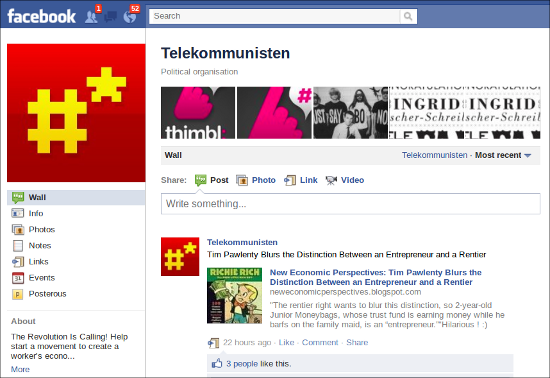
If I wanted to reach people and share information, I needed to do so on the technologies that others are using, which are not necessarily the ones I would prefer they use.
My criticism of Facebook and other sites is not they are not useful, it is rather that they are private, centralized, proprietary platforms. Also, simply abstaining from Facebook in the name of my own media purity is not something that I’m interested in, I don’t see capitalism as a consumer choice, I’m more interested in the condition of the masses, than my own consumer correctness. In the end it’s clear that criticizing platforms like Facebook today means using those platforms. Thus, I became a user and set up the Telekommunisten page. Unsurprisingly, it’s been quite successful for us, and reaches a lot more people than our other channels, such as our websites, mailing lists, etc. Hopefully it will also help us promote new decentralized channels as well, as they become viable.
MG: So, I downloaded deadSwap (http://deadSwap.net) which I intend to explore and use. On the site it says “The Internet is dead. In order to evade the flying monkeys of capitalist control, peer communication can only abandon the Internet for the dark alleys of covert operations. Peer-to-peer is now driven offline and can only survive in clandestine cells.” Could you explain the project? And are people using it as we speak?
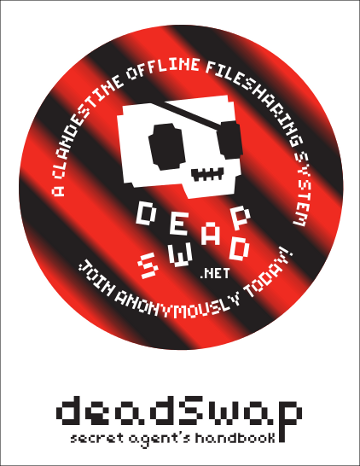
DK: I have no idea if people are using it, I am currently not running a network.
Like thimbl, deadSwap is an artwork. Unlike thimbl, which has the seeds of a viable platform within it, deadSwap is pure parody.
It was developed for the 2009 Sousveillance Conference, The Art of Inverse Surveillance, at Aarhus University. deadSwap is a distopian urban game where participants play secret agents sharing information on usb memory sticks by hiding them in secret locations or otherwise covertly exchanging them, communicating through an anonymizing SMS gateway. It is a parody of the “hacker elite” reaction to Internet enclosure, the promotion of the idea that new covert technologies will defeat attempts to censor the Internet, and we can simply outsmart and outmaneuver those who own and control our communications systems with clandestine technologies. This approach often rejects any class analysis out-of-hand, firmly believing in the power of us hackers to overcome state and corporate repressions. Though very simple in principal, deadSwap is actually very hard to use, as the handbook says “The success of the network depends on the competence and diligence of the participants” and “Becoming a super-spy isn’t easy.”
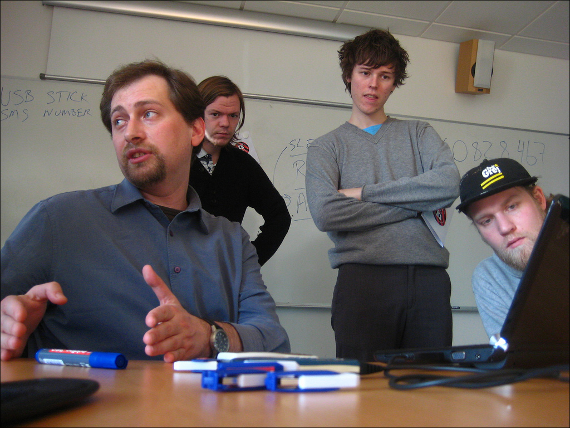
MG: What other services/platforms/projects does the Telekommunisten collective offer the explorative and imaginative, social hacker to join and collaborate with?
DK: We provide hosting services which are used by individuals and small organizations, especially by artists, http://trick.ca, electronic newsletter hosting (http://www.freshsent.info) and a long distance calling service (http://www.dialstation.com). We can often be found on IRC in#telnik in freenode. Thimbl will probably be a major focus for us, and anybody that wants to join the project is more than welcome, we have a community board to co-ordinate this which can be found here: http://www.thimbl.net/community.html
For those that want to follow my personal updates but don’t want don’t use any social media, most of my updates also go here: http://dmytri.info
Thank you for a fascintaing conversation Dmytri,
Thank you Marc 🙂
=============================<snip>
Top Quote: THE::CYBER.COM/MUNIST::MANIFESTO by Richard Barbrook. http://www.imaginaryfutures.net/2007/04/18/by-richard-barbrook/
The Foundation for P2P Alternatives proposes to be a meeting place for those who can broadly agree with the following propositions, which are also argued in the essay or book in progress, P2P and Human Evolution. http://blog.p2pfoundation.net
In the essay ‘Imagine there is no copyright and no cultural conglomerates too…” by Joost Smiers and Marieke van Schijndel, they say “Once a work has appeared or been played, then we should have the right to change it, in other words to respond, to remix, and not only so many years after the event that the copyright has expired. The democratic debate, including on the cutting edge of artistic forms of expression, should take place here and now and not once it has lost it relevance.”
Issue no. 4 Joost Smiers & Marieke van Schijndel, Imagine there are is no copyright and no cultural conglomorates too… Better for artists, diversity and the economy / an essay. colophon: Authors: Joost Smiers and Marieke van Schijndel, Translation from Dutch: Rosalind Buck, Design: Katja van Stiphout. Printer: ‘Print on Demand’. Publisher: Institute of Network Cultures, Amsterdam 2009. ISBN: 978-90-78146-09-4.
http://networkcultures.org/wpmu/theoryondemand/titles/no04-imagine-there-are-is-no-copyright-and-no-cultural-conglomorates-too/
Featured image: Games/03 Paul Sermon, Peace Games, © der Künstler 2008.
Das Spiel und Seine Grenzen: Passagen des Spiels II ed. Mathias Fuchs and Ernst Strouhal, (Springer Verlag, 2010), German language only.
Fuchs, Mathias; Strouhal, Ernst (Hrsg.)
1st Edition., 2010, 272 S. 16 Abb., Softcover
ISBN: 978-3-7091-0084-4
Versandfertig innerhalb von 3 Tagen
Mathias Fuchs is considered to be one of the first artists to explore the combination of videogames and art. Today he is a senior lecture at Salford University in England and a leading researcher on Game Art and ludic interfaces. Social and political context in videogames and how they affect our society has been a major topic in Fuch’s research. Last year he published, together with Ernst Strouhal, an anthology of videogames and its borders and how this genre is changing and influencing society. The background to the anthology was an exhibition held at Kunsthalle Wien in 2008 about art and politics in videogames.

It has been 60 years since Johan Huizinga’s now classic book Homo Ludens, the playing human, was published. Games are no longer just entertainment; it’s a major industry that is affecting our society in every aspect. In the foreword Fuchs states that the main issue for the 15 essays in the anthology is how games have changed and affected our society both politically and socially since they crossed over from the realms of entertainment into everyday experience.
Today we can find many different genres in videogames, such as serious games and persuasive games, that discuss current issues, news and social problems, artistic games which address existential and aesthetic aspects, and so on. The gaming community has grown enormously and created on-line worlds with strong virtual economics, attached real world economics. In her essay Daphne Dragona says “The virtual environments of our times therefore can be seen as social institutions with social, political and economic values resembling those of real life.”
In a similar way Tapio Mäkelä’s essay about locative games describes how the gamescene has entered the real world in the form of cos-players and social gameplays where videogames as Pacman are performed in the city streets or games as “/Noderunner/, where participants run to find open WiFi Networks, take a photo of themselves at the location and send the info via e-mail to the project’s website.” This begins to close the gap between networks and everyday experience through the practice of social gaming. The game as object is less of an obvious conclusion now that technology enables us to explore ourselves within networked, gaming contexts and mobile technologies.
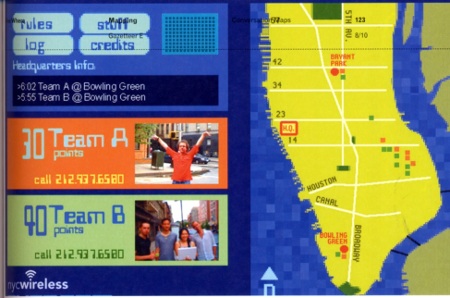
The borders between game and reality have now become even more blurred and integrated, especially if we consider how technology itself also crosses over into administrational activites which have already been traditional elements of controlling, processing parts of our lives. One example is how authorities around the world are supervising these new socio-economics, such as collecting taxes from virtual incomes by using similar tools and networks. There are many questions about how games will continue to affect and change our society in the future and the anthology takes an interesting and comprehensive look into what games have to offer and what could be potential threats to our future societies.
Today games are serious business. It is not impossible that in the future a bankruptcy of an on-line gameworld could shake the real world and create an economic depression. On the other hand, could on-line game economies bring prosperity and create new jobs, an economic boom in ways we have not witnessed before? If games move into a new period of changing social experience in even more connected ways than before, then we need to understand what the consequences of these are and how to navigate through this shifting terrain. One thing is for sure, it was a long time ago that games were just entertainment.
http://www.springer.com/new+%26+forthcoming+titles+%28default%29/book/978-3-7091-0084-4
Editors Ruth Catlow, Marc Garrett, Corrado Morgana.
Digital games are important not only because of their cultural ubiquity or their sales figures but for what they can offer as a space for creative practice. Games are significant for what they embody; human computer interface, notions of agency, sociality, visualisation, cybernetics, representation, embodiment, activism, narrative and play. These and a whole host of other issues are significant not only to the game designer but also present in the work of the artist that thinks and rethinks games. Re-appropriated for activism, activation, commentary and critique within games and culture, artists have responded vigorously.
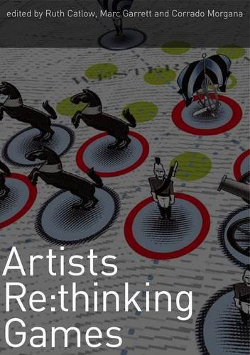
Over the last decade artists have taken the engines and culture of digital games as their tools and materials. In doing so their work has connected with hacker mentalities and a culture of critical mash-up, recalling Situationist practices of the 1950s and 60s and challenging and overturning expected practice.
This publication looks at how a selection of leading artists, designers and commentators have challenged the norms and expectations of both game and art worlds with both criticality and popular appeal. It explores themes adopted by the artist that thinks and rethinks games and includes essays, interviews and artists’ projects from Jeremy Bailey, Ruth Catlow, Heather Corcoran, Daphne Dragona, Mary Flanagan, Mathias Fuchs, Alex Galloway, Marc Garrett, Corrado Morgana, Anne-Marie Schleiner, David Surman, Tale of Tales, Bill Viola, and Emma Westecott.
In collaboration with FACT – http://www.fact.co.uk
http://www.furtherfield.org
http://www.http.uk.net/
Publisher: Liverpool University Press (31 Mar 2010)
Language English
ISBN-10: 1846312477
ISBN-13: 978-1846312472
http://www.amazon.co.uk/gp/offer-listing/1846312477
A Computer in the Art Room: The Origins of British Computer Arts 1950-1980
Catherine Mason
ISBN: 1899163891
JJG Publishing 2008
Computing anywhere else but its history often seems like a carefully guarded secret. This has been alleviated by activity around the resurrected Computer Arts Society in the 2000s, notably the acquisition of CAS’s archives by the V&A and the CaCHE project at Birbeck College which ran from 2002-2005. CaCHE, run by Paul Brown, Charlie Gere, Nick Lambert and Catherine Mason, produced conferences, exhibitions, and publications including the book “A Computer In the Art Room”, by Mason.
The art room of the title is the art department of British educational institutions prior to art becoming a degree-level subject. From the 1950s to the 1970s, when the cost of computing machinery dropped from the level where only major government and corporate organizations could afford them to the level where you only needed a second mortgage to afford one, the best way for artists to get access to the enabling technology of computing machinery was usually in an educational institution.
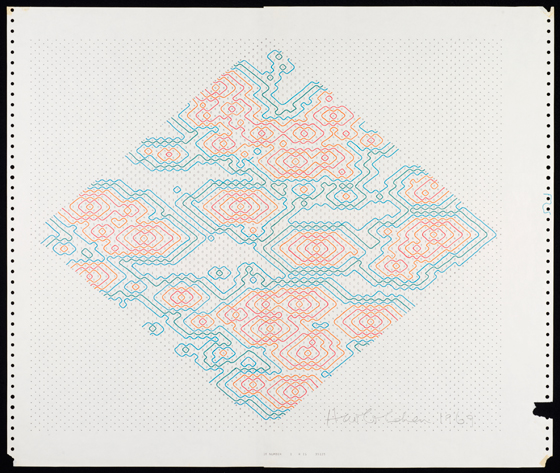
Mason starts out by describing the artistic and art educational situation in the UK at the time of the Festival Of Britain and the foundation of the ICA in London in the early 1950s. She then explains the structure and significance of the emergence of Basic Design teaching, the impact of the Coldstream report on art education, and the rise of the polytechnic colleges over the next thirty years. This provides vital context for the emergence of art computing teaching in the UK. It is also of more general interest for British art history. Conceptualism, performance, Land Art, the Hornsey Art School occupation, and the educational and media graphics that are currently being used as the basis of “hauntological” art all share this background and can better be understood and critiqued with better knowledge of it.
Basic Design courses started in London but didn’t remain there for long. They spread and matured throughout the UK, becoming entangled with the earliest teaching of art computing in provincial technical colleges. Mason traces the family trees of art computing teaching over time through these institutions and back to London-based institutions. Some of the names are familiar from art history (Richard Hamilton, Stephen Willats), some from art computing history (Harold Cohen, John Latham). Where the people involved cross over with cybernetic art, Conceptualism or other artistic currents Mason shows how their ideas fed into and from their art computing work.
The conceptual content of art computing followed the Bauhaus, cybernetics, systems, sociological and environmental influences on art from the 1950s to the 1970s. Its technological forms likewise followed those of mainstream computing. In the 1960s time was leased on mainframes or computers were built by hand. In the 1970s, minicomputers became available and art domain-specific software frameworks or programming languages were written by their users. In the 1980s, workstations with touch tablets, framebuffers, and increasingly proprietary software brought previously unprecedented power and ease of use at the cost of more fixed forms.
The history that I had to piece together as a student from hearsay and from hints in old publications, of the PICASO graphics language at Middlesex University that I found a print-out of the manual for when I was there in the 1990s, of Art & Language’s use of mainframe computers, of early cross-overs between art computing and dance, of cybernetic systems and games that attracted mass audiences before disappearing, is detailed, illustrated and contextualized in page after page of descriptions of hardware, software, institutions, courses and projects. The detail would be overwhelming where it not for Mason’s ability to bring the human and broader cultural aspect of it all to life.
There’s Jasia Reichardt’s Cybernetic Serendipity show at the ICA, Andy Inakhowitz’s Senster robot, John Latham’s dance notation experiments, The Environment Game, and computer graphics drawn with the languages and environments developed in UK art institutions. There’s pictures of the computer systems at the Slade, the RCA, Wimbledon and other art schools that serve as insights into the artists’ studios. There’s the Computer Arts Society, IRAT, APG. And, crucially, there’s the links between them told in a narrative that is coherent while still presenting the breaks and false starts in the story.
The history of “A Computer In The Art Room” reads all too often as brief moments of individuals triumphing against the odds to produce key works of art computing then fading into obscurity, academia or commerce. But any art history that considers a specific context at such a level of detail will look like this. Mason describes works, institutions and artists that deserve broader recognition, although she is under no illusion about how far the road to that recognition may be, citing the example of how long it has taken for photography to be recognized as art in the culturally conservative UK.
The social and pedagogical changes of the period covered by “A Computer In The Art Room” reflect a time of hope and ambition for education in society that made the academy less remote. Mason provides the social, technological and educational context needed to appreciate the very real achievements of art computing that she describes against this backdrop. As a slice of art history this is richly detailed. It touches on subjects far beyond art computing that will help any art student of history better understand the period covered. And it is both a relief and an inspiration to finally have a public record of this important aspect of the history of art computing in the UK.
The text of this review is licenced under the Creative Commons BY-SA 3.0 Licence.
Co-published by Furtherfield and The Hyperliterature Exchange.
Last October I received an e-mail headed “Introducing Vook”:
The Vook Team is pleased to announce the launch of our first vooks, all published in partnership with Atria, an imprint of Simon & Schuster, Inc. These four titles… elegantly realize Vook’s mission: to blend a book with videos into one complete, instructive and entertaining story.
The e-mail also included a link to an article about Vooks in the New York Times:
Some publishers say this kind of multimedia hybrid is necessary to lure modern readers who crave something different. But reading experts question whether fiddling with the parameters of books ultimately degrades the act of reading…
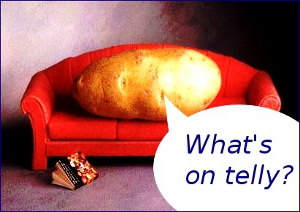
Note the rather loaded use of the words “lure”, “crave”, “fiddling” and “degrades”. The phraseology seems to suggest that modern readers are decadent and listless thrill-seekers who can scarcely summon the energy to glance at a line of text, let alone plough their way through an entire book. If an artistic medium doesn’t offer them some form of instant gratification – glamour, violence, excitement, pounding beats, lurid colours, instant melodrama – then it simply won’t get their attention. But publishers have a moral duty not to pander to their readers’ base appetites: the New York Times article ends by quoting a sceptical “traditional” author called Walter Mosley –
“Reading is one of the few experiences we have outside of relationships in which our cognitive abilities grow,” Mr. Mosley said. “And our cognitive abilities actually go backwards when we’re watching television or doing stuff on computers.”
In other words, reading from the printed page is better for your mental health than watching moving pictures on a screen: an argument which has been resurfacing in one form or another at least since television-watching started to dominate everyday life in the USA and Europe back in the 1950s. To some extent this is the self-defence of a book-loving and academically-inclined intelligensia against the indifference or hostility of popular culture – but in the context of a discussion of Vooks, it can also be interpreted as a cry of irritation from a publishing industry which is increasingly finding the ground being scooped from under its feet by younger, sexier, more attention-grabbing forms of entertainment.
The fact that the Vook publicity-email links to an article which is generally rather sniffy and unfavourable about the idea of combining video with print no doubt reflects a belief that all publicity is good publicity – but it is also indicative of the publishing industry’s mixed attitudes towards the digital revolution. On the whole, up until recently, they have tended to simply wish it would just go away; but they have also wished, sporadically, that they could grab themselves a piece of the action. But those publishers who have attempted to ride the digital surf rather than defy the tide have generally put their efforts and resources into re-packaging literature instead of re-thinking it: and the evidence of this is that the recent history of the publishing industry is littered with ebooks and e-readers, whereas attempts to exploit the digital environment by combining text with other media in new ways have generally been ignored by the publishing mainstream, and have therefore remained confined to the academic and experimental fringes.
The publishing industry’s determination to make the digital revolution go away by ignoring it has been even more evident in the UK than in the US. The 1997 edition of The Writers’ and Artists’ Yearbook, for example, contains no references to ebooks or digital publishing whatsoever, although it does contain items about word-processing and dot-matrix printers. On the other hand, Wired magazine was already publishing an in-depth article about ebooks in 1998 (“Ex Libris” by Steve Silberman, http://www.wired.com/wired/archive/6.07/es_ebooks.html) which describes the genesis of the SoftBook, the RocketBook and the EveryBook, as well as alluding to their predecessor, the Sony BookMan (launched in 1991). Even in the USA, however, enthusiasm for ebooks took a tremendous knock from the dot-com crash of 2000. Stephen Cole, writing about ebooks in the 2010 edition of The Writers’ and Artists’ Yearbook, summarises their history as follows:
Ebook devices first appeared as reading gadgets in science fiction novels and television series… But it was not until the late 1990s that dedicated ebook devices were marketed commercially in the USA… A stock market correction in 2000, combined with the generally poor adoption of downloadable books, sapped all available investment capital away from internet technology companies, leaving a wasteland of broken dreams in its wake. Over the next two years, over a billion dollars was written off the value of ebook companies, large and small.
After 2000, there was a widely-held view (which I shared) that the ebook experiment had been tried and failed: paper books were a superb piece of technology, and perhaps a digital replacement for them was simply never going to happen. There were numerous problems with ebooks: too many different and incompatible formats, too difficult to bookmark, screens hard to read in direct sunlight, couldn’t be taken into the bath, etc. But ebooks have always had a couple of big points in their favour – you can store hundreds on a computer, whereas the same books in paper form demand both physical space and shelving, you can find them quickly once you’ve got them, and they’re cheap to produce and deliver. Despite the dot-com crash and general indifference of the reading public, publishers continued to bring out electronic editions of books, and a small but growing number of people continued to download them.
Things really started to change with the launch of Amazon’s Kindle First Generation in 2007. It sold out in five and a half hours. With the Kindle, the e-reader went wireless. Instead of having to buy books on CDs or cartridges and slot them into hand-helds, or download them onto computers and then transfer them, readers using the Kindle could go right online using a dedicated network called the Whispernet, and get themselves content from the Kindle store.
Despite this big step forward, the Kindle was still an old-school e-reader in some respects: it had a black and white display, and very limited multimedia capabilities. The Apple iPad changed the rules again when it was launched in April 2010. The iPad isn’t just an e-reader – it’s “a tablet computer… particularly marketed for consumption of media such as books and periodicals, movies, music, and games, and for general web and e-mail access” (Wikipedia, http://en.wikipedia.org/wiki/I-pad). Its display screen is in colour, and it can play MP3s and videos or browse the Web as well as displaying text. For another thing, it goes a long way towards scrapping the rule that each e-reader can only display books in its own proprietary format. The iPad has its own bookstore – iBooks – but it also runs a Kindle app, meaning that iPad owners can buy and display Kindle content if they wish.
It seems we may finally be reaching the point where ebooks are going to pose a genuine challenge to print-and-paper. Amazon have just announced that Stieg Larsson’s The Girl with the Dragon Tattoo has become the first ebook to sell more than a million copies; and also that they are now selling more copies of ebooks than books in hardcover.
It is certainly also significant that the past couple of years have seen a sudden upsurge of interest in the question of who owns the rights over digitised book content, and whether ordinary copyright laws apply to online text – a debate which has been brought to the boil by a court case brought against Google in 2005 by the Authors Guild of America.
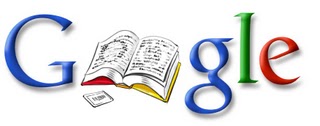
In 2002, under the title of “The Google Books Library Project”, Google began to digitise the collections of a number of university libraries in the USA (with the libraries’ agreement). Google describes this project as being “like a card catalogue” – in other words, primarily displaying bibliographic information about books rather than their actual contents. “The Library Project’s aim is simple”, says Google: “make it easier for people to find relevant books – specifically, books they wouldn’t find any other way such as those that are out of print – while carefully respecting authors’ and publishers’ copyrights.” They do concede, however, that the project includes more than bibliographic information in some instances: “If the book is out of copyright, you’ll be able to view and download the entire book.” (http://books.google.com/googlebooks/library.html)
In 2004 Google launched Book Search, which is described as “a book marketing program”, but structured in a very similar way to the Library Project: displaying “basic bibliographic information about the book plus a few snippets”; or a “limited preview” if the copyright holder has given permission, or full texts for books which are out of copyright – in all cases with links to places online where the books can be bought. Interestingly, my own book Outcasts from Eden is viewable online in its entirety, although it is neither out of copyright nor out of print, which casts a certain amount of doubt on Google’s claim to be “carefully respecting authors’ and publishers’ copyrights”.
In 2005 the Authors Guild of America, closely followed by the Association of American Publishers, took Google to court on the basis that books in copyright were being digitised – and short extracts shown – without the agreement of the rightsholders. Google suspended its digitisation programme but responded that displaying “snippets” of copyright text was “fair use” under American copyright law. In October 2008 Google agreed to pay $125 million to settle the lawsuit – $45.5 million in legal fees, $45 million to “rightsholders” whose rights had already been infringed, and “$34.5 million to create a Book Rights Registry, a form of copyright collective to collect revenues from Google and dispense them to the rightsholders. In exchange, the agreement released Google and its library partners from liability for its book digitization.” (http://en.wikipedia.org/wiki/Google_Book_Search_Settlement_Agreement). The settlement was queried by the Department of Justice, and a revised version was published in November 2009, which is still awaiting approval at the time of writing.
The settlement is a complex one, but its most important provision as regards the future of publishing seems to be that “Google is authorised to sell online access to books (but only to users in the USA). For example, it can sell subscriptions to its database of digitised books to institutions and can sell online access to individual books.” 63% of the revenue thus generated must be passed on to “rightsholders” via the new Registry. “The settlement does not allow Google or its licensees to print copies of books in copyright.” (“The Google Settlement” by Mark Le Fanu, The Writers’ and Artists’ Yearbook 2010, pp. 631-635).
Google, it will be noted, are now legally within their rights to continue their digitisation programme. This means they don’t have to ask anyone’s permission before they digitise work. If authors or publishers would prefer not to be listed by Google it is up to them to lodge an objection online. Google would argue that in launching their Library Project and Books Search they have merely been seeking to make their search facilities more complete, and thus to “make it easier for people to find relevant books” – but whether or not they have been deliberately plotting their course with wider strategic issues in mind, the end result has been to make them the biggest single player – almost the monopoly-holder – where digital book rights are concerned. As a reflection of this, an organisation called the Open Book Alliance has been set up to oppose the settlement, supported by the likes of Amazon and Yahoo: “In short,” their website claims, “Google’s book digitization strategy in the U.S. has focused on creating an impenetrable content monopoly that violates copyright laws and builds an unfair and legally insurmountable lead over competitors.” (http://www.openbookalliance.org/)
Whatever the pros and cons of the Google Settlement, it has undoubtedly helped to focus the minds of writers and publishers alike on the question of digital rights. Copyright laws and publishers’ contracts were designed to deal with print and paper, and until very recently there has been almost no reference at all to electronic publication. Writers who have agreed terms with a publisher for reproduction of their work in print have theoretically been at liberty to re-publish the same work on their own websites, or perhaps even to collect another fee for it from a digital publisher; and conversely, publishers who have signed a contract to bring out an author’s work in print have sometimes felt free to reproduce it electronically as well, without asking the writer’s permission or paying any extra money.
But things are beginning to change. A June 2010 article in The Bookseller notes that Andrew Wylie, one of the most prestigious of UK literary agents, “is threatening to bypass publishers and license his authors’ ebook rights directly to Google, Amazon or Apple because he is unhappy with publishers’ terms.” This is partly because he believes electronic rights are being sold too cheaply to the likes of Apple: “The music industry did itself in by taking its profitability and allocating it to device holders… Why should someone who makes a machine – the iPod, which is the contemporary equivalent of a jukebox – take all the profit?” Clearly, electronic rights are going to be taken much more seriously from now on.
Further indications that authors, publishers and agents are beginning to wake up and smell the digital coffee can be found in the latest editions of The Writers’ and Artists’ Yearbook and The Writers’ Handbook. For those who are unfamiliar with them, these annual publications are the UK’s two main guides to the writing industry. The 2010 edition of The Writer’s Handbook opens with a keynote article from the editor, Barry Turner, entitled “And Then There was Google”. As the title indicates, its main subject is the Google settlement and its implications – but its broader theme is that the book trade has been ignoring the digital revolution for too long, and can afford to do so no longer:
In the States… sales of e-books are increasing by 50 per cent per year while conventional book sales are static. An indication of what is in store was provided at last year’s Frankfurt Book Fair where a survey of book-buying professionals found that 40 per cent believe that digital sales, regardless of format, will surpass ink on paper within a decade.
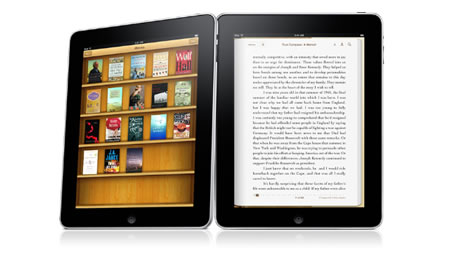
The Writers’ and Artists’ Yearbook is more conservative in tone, but if anything its coverage is more in-depth. It has an entire section titled “Writers and Artists Online”, which leads with an article about the Google settlement. In addition there are articles on “Marketing Yourself Online”, “E-publishing” and “Ebooks”. Even in the more general sections of the Yearbook there is a widespread awareness of how digital developments are affecting the book trade. For example, there is a review (by Tom Tivnan) of the previous twelve months in the publishing industry, which acknowledges the importance not just of ebooks but print-on-demand:
Amazon’s increasing power underscores how crucial the digital arena is for publishing… Ebooks remain a miniscule part of the market,… yet publishers and booksellers say they are pleasantly surprised at the amount of sales… And it is not all ebooks. The rise of print-on-demand (POD) technology (basically keeping digital files of books to be printed only when a customer orders it) means that the so-called “long tail” has lengthened, with books rarely going out of print… POD may soon be coming to your local bookshop. In April 2009, academic chain Blackwell had the UK launch of the snazzy in-store Espresso POD machine, which can print a book in about four minutes…
There is also an article about “Books Published from Blogs” (by Scott Pack):
Agents are proving quite proactive when it comes to bloggers. Some of the more savvy ones are identifying blogs with a buzz behind them and approaching the authors with the lure of a possible book deal… Many bestsellers in the years to come will have started out online.
Most of the emphasis in these articles falls on the impact which digital developments are having on the marketing of books rather than the practice of writing itself. But now and again there are signs of a creeping awareness that digitisation may actually change the ways in which our literature is created and consumed. In The Writer’s Handbook, Barry Turner attempts to predict how the digital environment may affect the practice of writing in the coming years:
Those of us who make any sort of livng from writing will have to get used to a whole new way of reaching out to readers. Start with the novel. Most fiction comes in king-sized packages… Publishers demand a product that looks value for money… But all will be different when we get into e-books. There will be no obvious advantage in stretching out a novel because size will not be immediately apparent… Expect the short story to make a comeback… The two categories of books in the forefront of change are reference and travel. Their survival… is tied to a combination of online and print. Any reference or travel book without a website is in trouble, maybe not now, but soon.
Scott Pack’s article on “Books Published from Blogs” tends to focus on those aspects of a blog which may need remoulding to suit publication in book form; but an article by Isabella Pereira entitled “Writing a blog” is more enthusiastic about the blog as a form in its own right:
The glory of blogging lies not just in its immediacy but in its lack of rules… The best bloggers can open a window into private worlds and passions, or provide a blast of fresh air in an era when corporate giants control most of our media… Use lots of links – links uniquely enrich writing for the web and readers expect them… What about pictures? You can get away without them but it would be a shame not to use photos to make the most of the web’s all-singing, all-dancing capacities.
Even here, however, the advice stops short of videos, sound-effects or animations. Another article in The Writers’ and Artists’ Handbook (“Setting up a Website”, by Jane Dorner) specifically forbids the use of animations:
Bullet points or graphic elements help pick out key words but animations should be avoided. Studies show that the message is lost when television images fail to reinforce spoken words. The same is true of the web.
It’s a little difficult to fathom exactly what point Dorner is trying to make here, but it seems to be something along the lines that using more than one medium may have a distracting rather than enhancing effect. If the spoken words on your television are telling you one thing, but the pictures are telling you another, then “the message is lost”. Perhaps a more interesting point, however, is where Dorner draws her dividing-line between acceptable and unacceptable practice. “Bullet points or graphic elements” are all right, because they “help pick out key words”, but “animations should be avoided”. In other words visual aids are all very well as long as they remain to subservient to text. They minute they threaten to replace it as the focus of attention, they become undesireable.
Clearly this point of view continues to enjoy a lot of support, particularly from traditionalists in the writing and publishing industries. All the same, combinations of text with other media may be about to enjoy some kind of vogue; and the development of the Vook brand since its launch last October is an instructive case-history in this regard.
When Vooks were first launched it seems fair to say that they were broadly greeted with a mixture of indifference and scorn. Reviews which appeared in the first couple of months after the launch were usually either lukewarm of downright unfavourable. Here, for example, is one from Janet Cloninger, writing in The Gadgeteer, November 2009:
So how were the video clips? Have you ever seen any of those old 60s TV shows where they were trying to show a bad acid trip? You know the crazy camera work, the weird color changes, the really bad acting?… I don’t think they added anything to the story at all… I found they were very distracting while trying to read.
Here is another from the Institute for the Future of the Book:
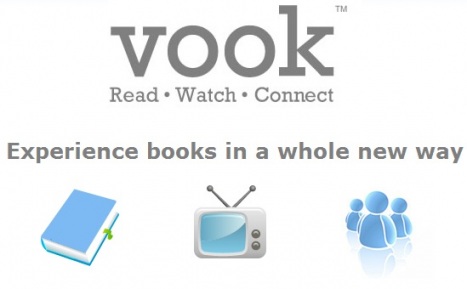
In terms of form the result is ho-hum in the extreme, particularly as there doesn’t seem to be much attempt to integrate the text and the banal video, which seems to exist simply to pretty-up the pages.
Following on from this generally unenthusiastic reception for the first Vooks, news about the brand over the next few months seemed to suggest that it was struggling to establish itself. In January 2010 Vook announced that they were publishing a range of “classic” titles, mostly for children – since “classic” normally means “out of copyright”, this seemed to imply that they were trying to boost their titles-list on the cheap. In February there was an announcement that Vook had raised an extra $2.5 million in “seed-financing” from a number of Silicon Valley and New York investors, suggesting that perhaps initial sales had been disappointing, Simon & Schuster had been reluctant to put up more money, and new sources of finance had therefore been sought.
With the launch of the iPad, however, it became obvious that Vook was making another throw of the dice. In April they launched 19 titles specially adapted for the iPad: In a statement, Bradley Inman, Vook CEO and founder said, “We will remember the iPad launch as the day that the publishing industry officially made the leap to mixed-media digital formats and never looked back…” The Vook blog makes this pinning-of-hopes on the iPad even more apparent:
The release of the iPad this Saturday was not just a red letter moment for Silicon Valley, it marked a turning point for the publishing and film industries, and a great opportunity for those invested in the future of media. The team at Vook has been working hard for months to prepare apps for submission to Apple… In many ways, it seems like the iPad was literally made for us…
And it seems their hopes may not have been misplaced. In May they launched a title about Guns’n’Roses (Reckless Road, documenting the creation of the Appetite for Destruction album), and lo and behold it was favourably greeted:
…unprecedented photos and memorabilia from the early years of one of the great rock bands from the 1980s and 1990s… If you are a true hard rock fan, and Guns ‘N’ Roses was one of your favorite bands, this app is worth the try. (PadGadget)
Now that I’ve had some time to read through Reckless Road and watch many of the videos included in it I can see the value of the Vook approach. It lends itself well to a product like this… This is an app any Guns N’ Roses fan would greatly appreciate. (Joe Wickert)
In June, the Vook version of Brad Meltzer’s bestseller Heroes for my Son was also favourably received:
It is easy to see the tremendous possibilities in the Vook format, especially when tied to a tablet device like the iPad. I very much enjoyed my first experience with a Vook mainly because I rapidly dropped my attempt to think of it as a Book with video plug ins. A Vook is really a multimedia platform that centers around text, rather than a traditional book. (MobilitySite)
Both these books are non-fiction – a genre in which the relationship between video footage and text seems far less problematic. It is interesting to note, however, that in both cases the non-linear structure of the Vook is singled out as a positive feature, compared to the sequential organisation of a traditional book:
It is charmingly non-linear and can be approached from many different angles. More a chocolate box than a book, especially if you are like me and enjoy really digging down into a subject while reading. (MobilitySite)
Remember that old VH1 series, Behind the Music? Canter’s Vook app feels like a modern version of that approach, with the added benefit that you can hop around the story to your heart’s content… (Joe Wickert)
There are hints here of a realisation that digital media can sometimes offer kinds of reading which are unavailable to, or hampered by, traditional print-and-paper.
Further recognition that ebooks with multimedia in them might actually have market appeal came at the end of June from none other than Amazon, who announced that they were adding audio and video to the Kindle iPhone/iPad app. The irony of this move is, of course, that Kindle ebooks are now multimedia-capable on the iPhone and iPad but not on the Kindle itself – an irony which can hardly be allowed to continue, and which therefore doubtless presages the launch of a multimedia Kindle some time in the near future.
Of course, the story of multimedia innovation in literature goes back much further than Vooks and the iPad. The British writer Andy Campbell, for example, has been publishing his own new media fiction online for years – most recently on the Dreaming Methods website. Most of his work has been designed in Flash, which the iPad unfortunately does not support. He therefore finds himself in the one-step-forward-and-two-steps-back position where new media literature is finally starting to make some headway in the marketplace, but thanks to a whim of the Apple corporation his own work in the field, developed over more than a decade, been landed with a big disadvantage. Understandably, his feelings are mixed:
It does indeed seem like there is a shift going on with digital fiction, although there are still a large number of stumbling blocks from a development point of view… Whilst the potential of the iPhone and iPad is undoubtedly exciting, a lot of authors – including myself – do not work with Macs or have the programming experience required to produce Apple-happy content…. However that’s from the point of view of Apple dominating the market and forcing everyone to use their SDK, whilst in actual fact Android holds considerable promise… I wouldn’t say digital fiction is breaking through into the mainstream – although perhaps it depends what you mean by digital fiction… Whether anything has been produced that really takes reading as an experience to a new level, I’m not sure.
Since Flash has hitherto been one of the main tools used by new media writers and artists, many of them will now find themselves in the same predicament as Campbell – and many of them will doubtless be hoping, like him, that alternative platforms such as Android are going to make some headway in the coming months. But leaving the question of platforms on one side, another difficulty for existing new media writers seems to be that although publishers are suddenly discovering a new enthusiasm for the form, they have very little knowledge or understanding of the work which has already been done, and very few links with those who have been doing it. Nor is this entirely the publishers’ fault, because there seems to be a genuine cultural divide between those who work in the publishing industry and those who take an interest in new media literature. Emily Williams of Digital Book World alludes to this divide in her article about this year’s London Book Fair (“Old London vs. New Media”, April 2010):
In most [publishing] houses, the digital innovators are still operating on a parallel plane, touching on but not fully integrated into the publishers’ core business centers. This segregation is so complete that much of the digital crowd is liable to skip the traditional fairs altogether, gravitating instead to their own tech confabs (which are in turn often boycotted by, or unknown to, the bookish folk).
Michael Bhaskar, a publisher and one of the judges of the Poole Literary Festival’s New Media Writing Prize, makes a similar point in his blog:
There has been no real conversation between the two [publishers and new media writers]. Why? It seems like we should have hit the meeting point where there could and should be a productive alliance, when in fact the gulf seems as wide as ever… Publishers have to sell books – or something – to keep going… [whereas] much new media writing is not designed to be commercial, being associated with a more recondite and experimental mindset.
In other words, publishers and new media writers have failed to come together, not simply because publishers have been hoping for the digital revolution to go away, nor because new media writers have been go-it-alone experimentalists, but because culturally they have belonged to different worlds, moved in different circles and spoken different languages.
Even assuming that these difficulties can be overcome, it is open to doubt whether new media writers will necessarily want to throw themselves headlong into the commercial mainstream. Many of them, like Andy Campbell, have been going it alone for so long that the habit of independence may be difficult to shake. Undoubtedly a bit of money would be very welcome, but advice from marketing men about how to make their work more commercial might be less well-received. On the publishing side of the equasion, however, there are definite signs that things are starting to change. Experimentation was the buzzword of the 2010 London Book Fair:
The publishing industry must move at speed to adopt new business models and new ways of working if it is to seize the opportunities of the digital revolution, delegates were told at London Book Fair… Industry figures focused on the need to experiment and to get a real understanding of what consumers want from the new technologies in a fast-changing environment. (The Bookseller)

There are also signs that the influence of digital technology on writing now extends beyond the software-savvy fringe, and is starting to affect the ways in which less specialised writers create their work. One of the surprize best-sellers of last year was a book called Important Artifacts and Personal Property from the Collection of Lenore Doolan and Harold Morris, Including Books, Street Fashion and Jewellery, by Leanne Shapton, which (as the title suggests) takes the form of an auction catalogue, selling off the belongings of a fictional couple. As befits an auction catalogue, the book consists of photographs of the articles for sale, accompanied by snippets of text –
Lot 1231: Two pairs of white shoes. Two pairs of white bucks. The label inside the men’s pair reads “Prada”, the women’s reads “Toast”. Sizes men’s 11, women’s 9. Well worn. $40-60.
The artefacts in the catalogue are arranged in chronological order, which makes it easier for them to tell the story of the couple’s love-affair; but despite this concession to linearity what is striking about the novel, to anyone who has had very much to do with new media literature, is how like a piece of new media literature it is. Experimental it may be as a novel in print, but as a piece of digital writing it would be fairly conventional, albeit unusually well-put-together. It was obviously composed as collection of objects and pictures as much as a a piece of written text; there is no conventional dialogue or storytelling; despite its chronological sequence there is a strong non-linear element to the book, a feeling that it is as much designed to be dipped and skimmed as to be read from one end to the other; it makes a knowing reference to Raymond Queneau, the Oulipo writer; and in many ways it would be more at home on the Web, where the pictures could be in full colour and zoomable at no extra expense.
Another example of the influence of digital technology on “ordinary” literature comes from the small-scale end of the publishing industry – Martha Deed’s poetry chapbook The Lost Shoe, which was published earlier this year by Dan Waber at Naissance Chapbooks (about whom, more in a moment). The first point to note about this collection is that in order to publicise it Martha made a video, also called “The Lost Shoe” (http://www.sporkworld.org/Deed/lostshoe.mov), which deserves to be thought of as a companion-piece rather than a “trailer”. The poems in the collection are based on Martha’s experiences as a psychologist specialising in family law – more specifically, they deal with cases in which family members have done violence to each other, and some of them are harrowingly raw:
Upstairs, he tried twice to change his clothes
his fingers slippery with your blood…
You were looking at him
the last person you saw before your death
It bothered him, that lifeless stare,
so he stepped over your mother
your dying baby sister
and tried to close your eyes…
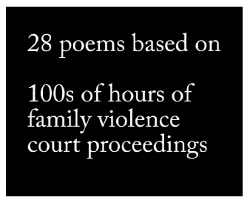
The video has the same combination of near-documentary authenticity and artistic control. It starts with a 911 telephone call from a man who has harmed his own children. There is a terrible moment when he is asked what has happened and he breaks into hysterical tears and says “They got stabbed”, as if somebody else might have done it. It ends with Martha reading aloud from one of her own poems, “Practice Tips”, which is based on the Center for Criminal Justice Advocacy‘s “Criminal Pre-Trial and Trial Practice”:
Play the tape 10 times at trial.
The jury will become accustomed to the carnage…
Obfuscate. Whine. Grandstand.
Fumble with your papers.
The fact that Martha feels equally at home working with both the written word and the camera, and therefore feels able to shoot her own video as a means of publicising her collection of poems, is an indication of the way in which digital technology is beginning to influence literary practice at grass-roots level. But the influence goes further. As well as conventional verse, her collection contains a number of visual poems – you could almost call them diagram poems – combining text with graphic design. “Jury Pool”, for example, shows a number of black stick-figures in and around the jury pool, labelled with reasons why they have been disqualified from the jury, or factors which will influence their outlook on the case: “Have to go back to school”, “Ate lunch with defendant’s mother”, “Crime victim”, “Don’t understand English”, and so forth. Including a diagram-poem such as this in a collection of poetry would not have been impossible before digital technology came along, but the fact that software packages such as Microsoft Word and Open Office Writer can handle images as easily as text, and make it simple to customise page-design without incurring any extra cost, means that poets now have an enormous range of experimental possibilities constantly at their fingertips.
Furthermore a lot of writers haven’t just moved beyond the pen or the portable typewriter to computers and word processing software; they have moved on to such things as blogs and web-pages, which have built-in multimedia capabilities. Sound-files and videos are rapidly becoming a normal part of the amateur writer’s working environment, and as a result the combination of text with other media is becoming a grassroots staple rather than a specialists-only field.
The Lost Shoeis published by Naissance Chapbooks, run by Dan Waber. A glance through Waber’s catalogue is enough to confirm the effect which digital technology is starting to have on poetic style. Amongst more formally conventional poetry he publishes, for example, Psychosis by Steve Giasson, which is based on comments collected by a YouTube posting of the shower scene from Psycho:
kthevsd Lame movies ? Kid I like all movies, old films, new films, etc. How is this classic lame ? Have you even ever watched it ? What would some 16 year old teenybopper know about cinema ? You probably have never even heard of Kurosawa and I bet you have never even seen a Daniel Day Lewis or Meryl Streep movie in your life. No wonder everyone laughs at your generations taste…
Or there is a collection by Jenny Hill called Regular Expressions: the Facebook status update poems –
Ron: I delivered a fucking BABY tonight! Yep, a fucking BABY!!!!!!!!! what did
u do today? Nursing school is AWESOME!!!!!!!
Someone asks if it was slimy, another wants
the placenta, most are stumped
at how to comment
on all your exclamation marks.
Then there is Watching the Windows Sleep by Tantra Bensko, which combines “fiction, poetry, and photographs”; or Open your I by endwar, which is “at times concrete, at times typoem, at times visual poem, at times conceptual poem, at times typewriter poem”. It is clear that the digital revolution has affected all of these collections in one way or another – either by making a wider range of experimental options available, or by providing them with their inspiration and subject-matter.
Of course, these are atypical exhibits, because Dan Waber, the publisher, is clearly interested in adventurous and experimental kinds of poetry. He also publishes a series called “This is Visual Poetry“, which now runs to about fifty full-colour booklets of visual poems, “answering the question [What is visual poetry?] one full-color chapbook at a time”, and answering it extremely variously. All the same, even allowing for Waber’s adventurous tastes, the fact that within a couple of years he has managed to put together fifty chapbooks of visual poetry, plus nineteen “conventional” poetry collections which often show clear signs of technological influence, is strongly suggestive of the directon in which things are moving.
Just as noteworthy is the business-model behind Waber’s publishing ventures. Basically, his operation relies on three key elements. The first is print-on-demand technology, which has almost completely done away with the printing expertise on which book production used to rely. These days, as long as writers can produce a competently-laid-out electronic original it can be turned into a book at the touch of a button. Colour reproduction is slightly more expensive than black-and-white, but not prohibitively so. Standards of reproduction are undoubtedly lower than they would be in the hands of a specialist printer, but most people never notice the difference. Self-publishing ventures such as Lulu (www.lulu.com) rely on this kind of print-on-demand process, and although Waber sends his electronic originals to the local print shop rather than using a completely automated online process, the technology is the same.
However, whereas the Lulu publishing process involves quite a bit of donkeywork (and usually a crash course in book-design and pagination) on the part of the author, the second key element of Waber’s publishing model is a drastically simplified and stringent set of layout criteria. Submissions to the visual poetry series must be “17 color images of visual poems of yours that are 600 pixels wide by 800 pixels tall”; and submissions to the Naissance chapbook series must be a maximum of 48 pages, in A4 portrait layout, with specified page-margins. Waber has designed a macro which takes Word files laid out according to these specifications and converts them instantaneously into print-ready book originals. This means that responsibility for the page layout is left squarely with the author – as Waber’s guidelines say, “all you need to do is make each page look how you want it to look… and we’ll convert it” – with the added effect that as long as authors stay within the guidelines, they are free to experiment as much as they like.
This combination of strict limitations and artistic freedom has undoubtedly helped to foster some of the adventurous design his chapbook series displays. At the same time, however, Waber has eliminated so much complexity from the publishing process that the third key element of the business model looks after itself: his costs (including time-costs) have come right down, to the point where he can show a modest profit on print-runs as low as ten units. All he has to do is decide whether he wants to publish something: if he does, he runs his macro, sends his print-ready file to the printer, and has ten copies of the chapbook in his hands within 24 hours. As he writes with understandable pride:
The beauty in all of this is no cash outlay. No huge print runs. No wondering if there’s grant money to support it, no worrying if it’ll actually sell enough to cover costs. It’s all profit after one copy sells… I am in a situation where because I make money off of every book I publish, all I need to do is find more books to publish. Because I de-complexified the process so completely.
Waber believes that his kind of venture represents the way forward for literary publishing in the era of digital technology, and he also believes that it is the kind of solution which can probably only come from outside the existing print industry, not from inside, because, as he puts it, “Big Publishing has a model that is blockbuster-based”. To explain this more fully, he cites an article by Clay Shirkey called “The Collapse of Complex Business Models“, which argues that big and complex businesses become unable to adapt to new circumstances, because their ideas about how they should operate become culturally embedded. If the new circumstances are sufficiently challenging then the only way forward will be for big organisations to collapse, and for new small ones, without the same culturally embedded assumptions, to take their place.
When ecosystems change and inflexible institutions collapse, their members disperse, abandoning old beliefs, trying new things, making their living in different ways than they used to… when the ecosystem stops rewarding complexity, it is the people who figure out how to work simply in the present, rather than the people who mastered the complexities of the past, who get to say what happens in the future.
This, argues Waber, is likely to be the ultimate effect of the digital revolution on the publishing industry; not simply dramatic changes in publishing formats and marketing methods, but a complete collapse of “Big Publishing”, and a multitude of small-scale, dynamic new ventures like his own, growing up out of the wreckage.
Clearly this is something that publishers themselves are worried about. As Michael Bhaskar writes in his blog for The Poole Literary Festival’s New Media Writing Prize,
On the writing side I often hear that people feel ignored by publishers.Essentially the world of commercial publishing is a closed shop unwilling to listen to the maverick, the outsider and the original, and will ultimately pay for this as audiences gravitate to newer and amorphous forms… This might be an argument for by-passing publishers or intermediaries altogether… [but] what I would like is mediation.
Clay Shirkey quotes the example of the “Charley bit my finger” video on YouTube to illustrate how production values have changed:
The most watched minute of video made in the last five years shows baby Charlie biting his brother’s finger… made by amateurs, in one take, with a lousy camera… Not one dime changed hands anywhere between creator, host, and viewers. A world where that is the kind of thing that just happens from time to time is a world where complexity is neither an absolute requirement nor an automatic advantage.

The “not one dime changed hands anywhere” line is perhaps a bit of an oversimplification. Wikipedia notes that “According to The Times, web experts believe the Davies-Carr family could earn £100,000 from ‘Charlie Bit My Finger’, mostly from advertisements shown during the video.” (http://en.wikipedia.org/wiki/Charlie_Bit_My_Finger) But the Davies-Carrs didn’t make or post the video with the intention of becoming celebrities or making money. They posted it so that it could be viewed by the boys’ godfather. The success of the video, in other words, owes nothing to its production values or to any marketing strategy, and everything to the environment created by YouTube and its viewers.
An alternative to the Big Publishing model is already with us, and despite odd viral phenomena like “Charlie Bit My Finger”, it consists in the main of very large numbers of small-scale products reaching small audiences, rather than small numbers of very high-profile products reaching huge audiences. This alternative model is enabled by digital technology, and it replaces high production values and market-minded editorial controls with the principle that people’s desire to publish themselves and to look at each other’s efforts is itself a profit motor. No single book published by Lulu, for example, has to sell a lot of copies for Lulu itself to make a profit – it’s the volume which counts. The same is true of YouTube, and it’s also true, on a much smaller scale, of Dan Waber’s enterprise.
YouTube is now crawling with people hoping to become the next viral phenomenon – and there are also a number of talented individuals who have built up sizeable audiences on YouTube and who are making decent amounts of money out of those audiences – but the really big money is being made not by the people who contribute material, but by YouTube itself. The same is true of print-and-paper publishing via Lulu. The removal of editorial constraint has greatly freed up and democratised the creative side of the publishing process, but on the other hand, a system where most writers made relatively small amounts of money compared to publishers and agents is being increasingly shoved aside by a new system where most creators make no money at all, while the publishers do very nicely.
Add to this the fact that YouTube is now in the hands of Google – the same Google which has been “creating an impenetrable content monopoly” over digitised books through the Google Books programme – and the future of publishing starts to look less like an open field for small enterprises, created by the collapse of big corporations, and more like a battleground where a few monster Web 2 corporations – Amazon/Kindle, YouTube/Google and Apple – are carving up the territory as fast as they can, much as the major European countries carved up Africa during the nineteenth century.
What the future really holds for the publishing industry is probably a mixture of these two scenarios. It’s unlikely that conventional publishing is going to disappear any time soon, but in a shrinking market publishers are going to be more and more reluctant to publish untried material, more and more inclined to go with material which seems to tap into an already-established audience. The celebrity biography or autobiography; the book of the comedy series; the first novel by a TV personality; these are already familiar. The book version of a popular blog and the “global distribution” edition of something which has already sold very well via the Web are going to become increasingly familiar in the near future. Add to this books with associated websites, increasing emphasis on ebooks, and a cautious trial of ebooks with interactive elements, and you have a pretty good picture of how the conventional publishing industry is shaping up to deal with the digital revolution.
In the meantime, entrepreneurs like Dan Waber are taking fuller advantage of the new possiblities offered by digital technology, and perhaps planting the seeds for a whole new generation of publishing houses; while writers like Martha Deed and Leanne Shapton, under the influence of the digital revolution, are redefining literary genres.
But one consideration which should not be overlooked in all this is the importance of open standards. The digital revolution itself is predicated not only on technical advances – such as broadband, print-on-demand, digital video and multimedia handheld devices – but on the Web itself, and in particular on the fact that the Web is non-commercial and belongs to all its users. Material which appears on the Web doesn’t have to comply with a proprietary format laid down by any one corporation: it has to comply with standards laid down by the World Wide Web Consortium. It is this open structure which has enabled the Web to develop so rapidly and to serve as a framework within which so many enterprises have been able to flourish. For the field of publishing to flourish in the same way, open standards need to prevail here as well – open standards for ebooks, for example, so that standards-complaint work will be viewable on a whole range of different devices. Only under those circumstances can small enterprises and individual artists stand some kind of chance against the big corporations.
http://www.hyperex.co.uk/reviewdigitalpublishing.php
© Edward Picot, August 2010
© The Hyperliterature Exchange
Ambient Information Systems
English, some texts in German. Translator: Nicholas Grindell
400 pages, 6-colour hardbound, 17.5 x 23 cm
edition of 1,500 unique & numbered.
now available at ambient.publishing.
ISBN-13: 978-0-9556245-0-6
Ambient Information Systems by Manu Luksch and Mukul Patel is a hardback book that presents writing, images and art by and about ambient.tv (Luksch and her collaborators) from during the last decade. Its purple and yellow cover tempered by a tracing paper slip-cover, contains almost four hundred pages of sans-serif text cleanly laid out among images and sidebars. As intermedia artists with a strong emphasis on research and dissemination. Recent works have addressed surveillance, corporate data harvesting, and the regulation of public space.
The material presented in the book ranges from written essays and project proposals through preparatory sketches, computer server log files and video screen grabs to modification of the printed book iteslf by unique rubber stamps and scribbling over sections of text. This diverse and detailed presentation of ambient.tv’s work provides an insight into the inspiration, planning and production of some conceptually and aesthetically rich new media art.
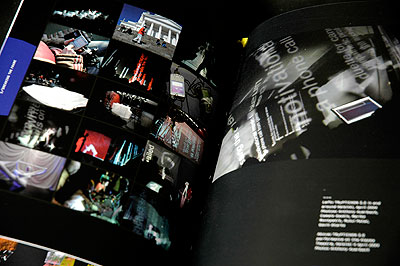
There’s a report from Kuwait during Ramadan 2002, a description of using cutting-edge wearable PCs, a discussion of the role of television, information about the harp in mythology, cyborg markets, the UK Data Protection Act, climate change, anti-gentrification, art and systems theory, UAVs, the Pacific plastic dead zone, and much, much more. There are projects that create free networks, dangerous musical instruments, taped-out surveillance camera boundaries, video installations, photographic images, movies of CCTV footage gained through freedom of information requests, manifestos, snowglobes, and cocktails.
(It’s a fascinating pleasure to read but it’s overwhelming to try and review.)
The portrait of Ambient.tv that emerges from all this is of intensive cultural critique pursued through a playful low-fi digital aesthetic. This isn’t a contradiction, the latter is in the service of the former. Ambient.tv’s projects and proposals tackle serious social and political issues. They do so through skilled use of the aesthetics and attitude of low-fi new media art and technological activism.
The wealth of ideas contained in the essays and other writing in the book show how historical, political and philosophical knowledge grounds the resulting art and indicates how it embodies a critique of contemporary culture.
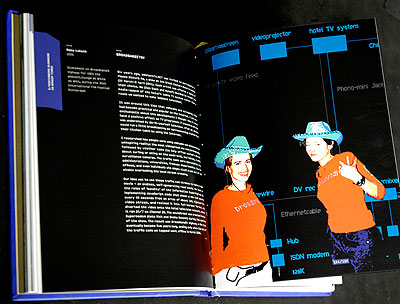
Contemporary culture as seen by Ambient.tv is surveillance culture, the database state with its DNA databases and laws that protect freedom by removing freedom. Ambient.tv is a realistic project, depicting the hidden forms of contemporary society that intrude into our lives. This is heavy stuff, and to air it critically without alienating the audience it requires precisely the playful touch that ambient.tv often bring to their art.
To take the example of FACELESS, 2007, (the first project I personally saw Luksch present), there is an exquisite balance between the disturbing idea of pervasive surveillance, the practical limitations of Freedom Of Information requests, and the visual and science-fictional narrative aesthetic that emerged from this. On their web site it states that it was produced “…under the rules of the Manifesto for CCTV Filmmakers. The manifesto states, amongst other things, that additional cameras are not permitted at filming locations, as the omnipresent existing video surveillance (CCTV) is already in operation.” The result is something more interesting and disturbing to watch than a simple collage of CCTV footage would be. The fact that the work can be made like this, that it can look like this, means something.
This strategy can be seen in “Mapping CCTV around Whitehall”, 2008, as well, which I also reviewed for Furtherfield here, and in many other pieces by Ambient TV.
Reading the proposals and essays shows the depth I suspected to this work, when I first saw it projected in a darkened room is there in its conception and execution.
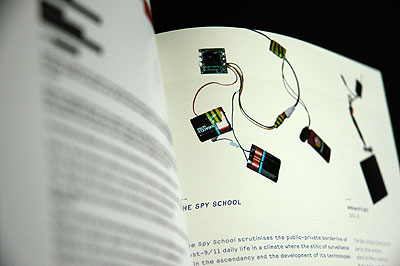
It’s an intense and inspiring experience to be faced with the textual equivalent of a decade-long open studio. The first essay in the book, a theory-laden piece by Fahim Amir, is almost overwhelming in a different way. It’s pure Theory, which will hopefully sell Ambient.tv to the artworld sectors that thrive on that sort of thing, but it isn’t the best introduction for newcomers to the project’s very accessible art.
But what a rare pleasure to be given such a wealth of insight into art that so acutely depicts our times. “Ambient Information Systems” is an important resource for contemporary artists and critics, an insight into the ideas and development of a very successful new media art practice. The grungey, playful, important realism of Ambient.tv’s work deserves presentation in a context that shows just what has gone into the art and just what people can get out of it. This is it.
The text of this review is licenced under the Creative Commons BY-SA 3.0 Licence.
Jaron Lanier
You Are Not A Gadget
2010
Allen Lane
ISBN 1846143411
Jaron Lanier’s book “You Are Not A Gadget” is a timely polemic, a cry of the soul in an increasingly soulless Web 2.0 world. I found reading it a frustrating and inspiring experience. For every time I wanted to throw the book at the wall in exasperation there was a time where Lanier spoke to a part of me that the cultural transition from 90s cyberpunk to 2010s cyberpreppy had optimised out.
Lanier is asking the right questions. What happens to our conception of what it means to be human when the way we represent our humanity is reduced to snippets of media on (micro-)blogs and social networking sites? How can we support a middle class of independent artists when the technology and economics of the Internet makes money directly only for the vectorialist media barons of Web 2.0? Will the technologically enabled troll class become a political threat akin to historical fascism?
These are questions that need asking, and Lanier asks them in an intelligent and open way. This is all the more impressive given his background as a champion of cyberculture. Lanier is not fearful or dismissive of the changes that the technology he championed has wrought. He is looking them in the eye and challenging their new proponents to explain the gap between their claims and their reality.
The problem is that Lanier’s answers crash and burn from a lack of detailed knowledge of non-cyber culture. He contrasts the managerialism and capitalism that he mis-identifies as materialism with a naive and easily exploited mystificatory spirituality. He accepts unquestioningly the music recording industry’s claim that the Internet has destroyed the economic and cultural value of music. And his characterisation of commons-based peer production as digital Maoism is wide of the mark.
To address just one of his examples; the cultural smog of the contemporary Internet follows the exhaustion of mass culture, it has not produced it. Napster is not to blame for the X Factor. The Beatles, generally regarded as a cultural highpoint of mass culture, were a reactionary throwback to earlier rock and roll tropes and were identified as such by Cliff Richard at the time. The well of mid-20th century black American music was returned to in the 1960s, 1970s 1980s and 1990s and was dry by the era of the parochial third-order nostalgia of Britpop. Crucially, Britpop pre-dates Napster and mass adoption of the MP3 file format. Lanier’s adopted narrative doesn’t add up.
But I come to praise Lanier, not to bury him in data. His is an ambitious critique, an important challenge to deeply ingrained cybercultural beliefs. We should all be so brave as to face the consequences of what we believe in so directly. And his final conclusions, not those of a disappointed cyber-hippy who should have been careful what he wished for but of someone who has kept faith in the potential of technology for us to realise ourselves, are as inspirational as they are accusatory.
You can google any number of blow-by-blow disagreements with Lanier’s thesis. And his own FAQ on the book is in many ways more convincing than the book itself. But if you have any interest in contemporary culture as it is mediated by technology you owe it to yourself to find your own points of difference and agreement with Lanier and to look beyond that to the spirit of what he is saying.
Which is that we should not be reifying and reducing our selves and our experiences into packets of data that the social robber barons of Web 2.0 can sell to marketing companies and government agencies. We should be using virtual reality and the other affordances of information technology to expand our consciousness and to grow as socialised individuals.
Web 2.0 can be oppressively straight and conformist. It doesn’t have to be like this. Don’t dismiss Lanier’s ambition to create a virtual reality system that could let him experience being an octopus. Wonder what it would be like to try it yourself, and how you would explain it to your friends.
Not the entries on your Facebook Friends list, your actual friends…
The text of this review is licenced under the Creative Commons BY-SA 3.0 Licence.
Data Soliloquies
Richard Hamblyn and Martin John Callanan
London: Slade Press, 2009
112 pages
ISBN 978-0903305044
Featured image: Data Soliloquies is a book about the extraordinary cultural fluidity of scientific data
Although much has been said about C.P. Snow’s concept of a “third culture”, we haven’t actually reached an understanding between the spheres of science and humanities. This is caused in part by the high degree of specialisation in each field, which usually prevents researchers from considering different perspectives, as well as the controversies that have arisen between academics, exemplified by publications such as Intellectual Impostures (1998) in which physicists Alan Sokal and Jean Bricmont criticise the “abuse” of scientific terminology by sociologists and philosophers. Yet there is a growing mutual dependency of both fields of knowledge, as the one hand our society is facing new problems and questions for which the sciences have adequate answers and on the other scientific research can no longer remain isolated from society. Some scientists, such as the astronomer Roger Frank Malina, have even argued that a “better science” will result from the interaction between art, science and technology. Malina presents as an example the “success of the artist in residence and art-science collaboration programs currently being established” [1], and considers the possibility of a “scientist in residence” program in art labs.

Our relationship with the environment is certainly one of the main problems we are going to face during this century and it is also a subject that brings up the necessary communication between science and society. The UCL Environment Institute [2] was established in 2003 to promote an interdisciplinary approach to environmental research and make it available to a wider audience. While being representative of almost every discipline in the University College London, it lacked an interaction with the arts and humanities. This gap has been bridged by establishing an artist and writer residency program in collaboration with the Slade School of Fine Arts and the English Department. Among 100 applications, writer Richard Hamblyn and artist Martin John Callanan were chosen for the 2008-2009 academic year: Data Soliloquies is the result of their work.
Despite “belonging” to the field of art and humanities, neither Hamblyn nor Callanan are strangers to science and technology. Richard Hamblyn is an environmental writer and historian who has developed a particular interest in clouds, and Martin John Callanan is an artist whose remarkably conceptual work merges art and different types of media. This may be the cause that Data Soliloquies is by no means a shy penetration into a foreign field of knowledge but a solid discourse which presents a richly documented critique of the apparently ineffective ways in which scientists have made society aware of such a crucial problem as that of climate change. The title of the book has been borrowed for a term that Jon Adams, researcher at the London School of Economics, coined to refer to Michael Crichton’s novels, who uses “scientific” facts to give his imaginative plots an aura of credibility. With this reference, the authors state that the way scientific data is presented actually constitutes a narrative, an uncontested monologue: “…scientific graphs and images have powerful stories to tell, carrying much in the way of overt and implied narrative content (…) these stories are rarely interrupted or interrogated.”[3]
As the amount of data regularly stored in all sorts of digital supports increases exponentially, and new forms of data visualisation are developed, these “data monologues” become ubiquitous, while remaining unquestioned. In his text, Hamblyn exposes the inexactitude in some popular visualisations of scientific data, which have set aside accuracy in favour of providing a more eloquent image of what the gathered evidences are supposed to tell. On the one hand, Charles D. Keeling’s upward trending graph of atmospheric carbon dioxide concentration, which according to Hamblyn is “probably the most important data set in environmental science, and has become something of a freestanding scientific icon”[4], or Michael Mann’s controversial “Hockey Stick” graph are illustrative examples of the way in which information displays have developed their own narratives. On the other, the manipulation of data in order to obtain a more visually effective presentation, such as NASA’s exaggeration of scale in their images of the landscape of Venus or the use of false colours in the reproductions of satellite images, call for a questioning of the supposed objectivity in the information provided by scientific institutions.

In the field of climate science, the stories that graphs and other visualisations can tell have become of great importance, as human activity has a direct impact on global warming, but this relation of cause and effect cannot be easily determined. As Hamblyn states: “climate change is the first major environmental crisis in which the experts appear more alarmed than the public” [5]. The catastrophism with which environmental issues are presented to the public generate a feeling of impotence, and thus any action that an individual can undertake seems ineffective. The quick and resolute reaction of both the population and the governments in the case of the “ozone hole” in 1985 points in the direction of finding a clear and compelling image of the effects of climate change. As Hamblyn underscores, this is not only a subject for engineers: “the reality of ongoing climate change has yet to be embraced as a stimulus to creativity –in the arts as well as the sciences– or as a permanent and inescapable part of human societal development” [6].
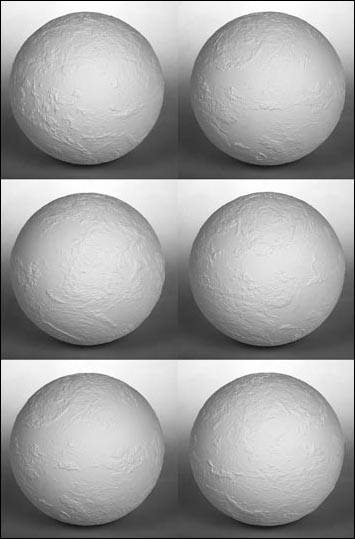
Martin John Callanan took upon himself to develop a creative response to this issue, and has done so, not simply by creating images or objects but by depicting processes. He states: “I’m more interested in systems –systems that define how we live our lives” [6]. A quick look at his previous work [7] will show how appropriate this statement is: he has visited each and every station of the London underground, collected every command of the Photoshop application in his computer, officially changed his name (to the same he already had), gathered the front page of hundreds of newspapers from around the world and engaged himself in many other activities that are as systematic and mechanical as ironic, poetic or simply nihilistic. During his residency, Callanan created to main projects. The first one, Planetary Order, is a globe in which the patterns of the clouds on a particular date (February 6th, 2009) have been sculpted. The artist composed the readings of NASA’s cloud monitoring satellites in a virtual 3D computer model, which was then laser melted on a compacted nylon powder sphere at the Digital Manufacturing Centre at the UCL Bartlett Faculty of the Built Environment. The resulting object is a sculpture, an artwork more than any sort of model in the sense that it develops a discourse beyond the actual presentation of data. An impeccable white sphere textured by its subtle protuberances, the globe evokes the perfection of an ancient marble sculpture while presenting us with an uncommon view of the Earth, covered with clouds. The clouds, which are usually erased in the depictions of our planet in order to let us see the shapes of the continents (the land which is our dominion), become an icon of climate change and the image of an order which is, in all senses, above us. Callanan freezes the planetary order of clouds in an impossible map, a metaphorical object which appears to us as a faultless, yet fragile and inscrutable machine.
The second of Callanan’s artistic projects is the series Text Trends. Using Google data, the artist has collected the number of searches for selected terms related to climate change in a time range of several years (from 2004 to 2007-2008). With this data, he has generated a series of minimalistic graphs in which two jagged lines, one red and the other blue, cross the page describing the frequency of searches (or popularity) for two competing terms. The result resembles an electrocardiogram in which we can see the “life” of a particular word, as opposed to another, in a simple but eloquent dialogue of abstract forms. Callanan has chosen to confront terms in pairs such as “summer vs. winter”, “climate change vs. war on terror” or “global warming”. Simple as they may seem, the graphs are telling and constitute and visual summary of the book whilst suggesting many other reflections. The final conclusion is presented in the last graph, in which the perception of climate change is expressively described by the image of a vibrant line for the word “now”, much higher in the chart than the flat line for the word “later”.
Pau Waelder
We Feel Fine: An Almanac of Human Emotion
Jonathan Harris and Sep Kamvar
Scribner Book Company, December 2009
ISBN 1439116830
Featured image: We Feel Fine project poster
“We Feel Fine – An Almanac Of Human Emotion” is a hardback book that in just under 300 pages of well designed montages, data visualisations, diagrams, illustrations and text presents and analyses the data gathered by the We Feel Fine project. Started in 2005 and launched in early 2006 by Jonathan Harris and Sep Kamvar, We Feel Fine is based around a database assembled using a webcrawler that searches the blogosphere for statements of the form “I feel” or “I feel like”. Any matches are stored along with as much contextual data as the webcrawler can find (a photograph nearby in the blog post, the poster’s age, gender, and location, local weather). The database contained twelve million such entries by the time the book was published.
Sections of the book categorise statements of feelings by age, gender, the location of the poster, and subject of the statement. Individual statements are presented superimposed over images found in the same blog post. The photographs presented with their accompanying expressions of emotion have a high-contrast, shallow depth of field, and highly focused look that resembles Lomography. But this is a product of the presentation of photographs on the web rather than an hipsterly ironic invocation of the contingent aesthetics of mass photography. The images are for the most part JPEGs, and show the contrast, mach banding and visual noise of that technology.
The montages of “I feel…” statements in a standard format superimposed over an image found in the same blog post serve to provide a (sometimes incongruous) context for the statements that the project is based on. They resemble Gillian Wearing’s “Signs that say what you want them to say and not Signs that say what someone else wants you to say” 1992-3 featured photographs of people holding up placards on which the artist had asked them to write down what was on their mind. Going back further into the history of art, the montages and in a novel way particularly the data visualisations and graphs bear comparison to Vermeer’s seventeenth Century paintings of bourgeois social relations and reverie. Both “Girl reading a Letter at an Open Window” and “We Feel Fine” present social class, social self-presentation, advanced communication technology and consideration of the thoughts of others in a medium and way that epitomises the way people see things in that era.
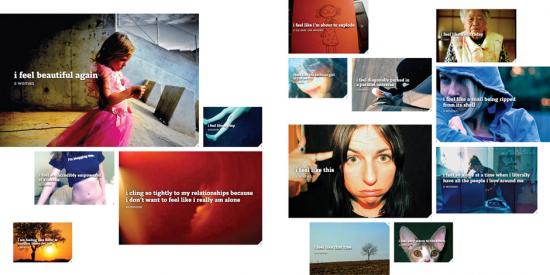
The book’s volume of data and graphics quantifying social phenomena might resemble a “state of the blogosphere” corporate social media report in some ways, but its presentation directs attention back to the emotions featured rather than trying to tie them to any corporate or governmental agenda. This is a book by, about and for individuals in contemporary mediatised society. I found reading it became quite overwhelming sometimes once I had adjusted to its presentation.
Dictionary definitions, statistical breakdowns of the kinds of words, ages and genders of bloggers and other demographic and affective data are presented in compact graphic form on every page, and larger charts show more general conclusions. Feelings, or the words used to refer to them, are shown to vary between genders and as people age. This is an exemplary application of Edward Tufte’s science of the graphical presentation of information. They even have sparklines. But that science is applied to data that is at its heart qualitative rather than quantitative.
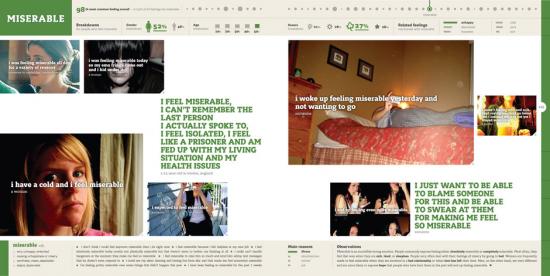
Such “data visualization” was a hot trend in 2009. Visualisations of crime rates, corruption, climate change and other issues can be produced using such data, and have become an important weapon in the arsenal of visual persuasion. On the We Feel Fine web site, feeling data is mapped to coloured blobs in an interactive user interface to the constantly updated (every minute) database. In the book, feelings and demographic information are processed to produce graphics that represent the prevalence of feelings over time, between genders, in different locations and in relation to each other. But as visual persuasion this is directed back to the vividness of human, qualitative experience rather than a more political or economic agenda.
“Sentiment analysis” was also hot trend in social media marketing in 2009 and its limitations quickly became apparent. Current systems simply cannot handle irony, sarcasm, regional differences in the usage of words and in many cases even simple negation. The We Feel Fine system is an exercise in gathering affective or sentiment data to visualise, but it avoids the pitfalls of sentiment analysis by automating only the gathering of the statements of emotion themselves, not analysis of how they relate to what they refer to. This is a classic example of well-chosen limits strengthening a project.
The problem of the relationship between qualitative (how you feel) and quantitative (how many people feel what you feel) data and how to deal with this in a non-voodoo way are avoided in We Feel Fine because of this.
Another 2009 hot trend was “big data”, the assembling of datasets that vary from many megabytes to many gigabytes in size. Datasets from regional and national governments, scientific research and freedom of information requests can be used in “data mining” to search for facts among the numbers. The We Feel Fine system is a good example of a big data dataset (and API, application programming interface, for accessing that data over the web). Unlike global temperature data it neither offers the possibility of objective accuracy nor involves any great risk if it lacks it. But it does reintroduce the human subjectivity that big data threatens to replace with numbers.
The striking thing about this is that although the We Feel Fine book is very much of the zeitgeist for 2009 the web-based system it presents started five years ago in 2005. At that time blogs were regarded by the mass media as disposable, narcissistic and somehow inauthentic. They were an unlikely subject at that time for art concerned with the authentic expression of emotion. We Feel Fine’s history, subject and results therefore both prefigure and go beyond the current state of the art in Internet social and corporate culture.
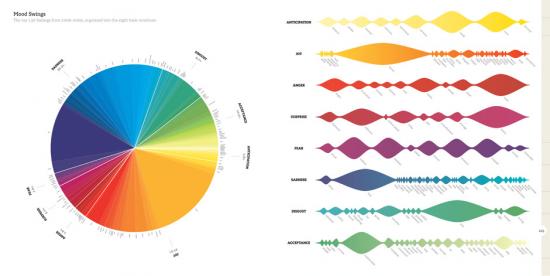
Harris and Kamvar are admirably candid in laying out the history, methodology, technology and in the case of the book’s production even the finances of their project. The code listings included in the book are tantalising glimpses into how the We Feel Fine server works, allowing a rare chance for students and artists to study such a system, and are licenced under the GPLv3. The book is under the obscure but principled Creative Commons “Founders Copyright” licence which will automatically expire the copyright on the book in twenty years time. This is all invaluable for critique and study of the project by artists, academics and anyone with an interest in art and technology, and more artists should do it.
In the FAQ and other essays contained in the book Harris and Kamvar are open about the methodological strengths and weaknesses of the We Feel Fine system. They acknowledge the limitations and demographics inherent in profiling bloggers (who are younger, wealthier and more technologically savvy than is usual). They also make a convincing case for the very real conceptual strengths of the project, discussing how the system holds up as science and statistics. And the project itself is overwhelming as an aesthetic and, strangely, somehow as a social experience.
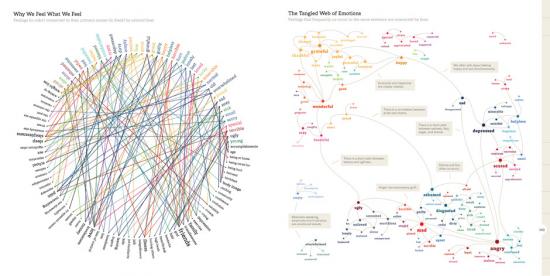
Even if we don’t deny or question the existence or status of emotions for ideological reasons, do we know what we really feel? And even if we do know what we really feel can we really express it in a way that will be understood by others? We Feel Fine doesn’t address these questions. They are outside of its scope. Its acceptance of sentiment at face value and its mechanical (re-)production of representations of sentiment might look like the hallmarks of kitsch. But that would deny the subjectivity of the original authors of the expressions of sentiment that We Feel Fine processes. And a progressive art needs to represent the masses, not merely rulers and pop stars. Not everyone will be feeling ironic or critical on any given day. Given this, the transparency, scale and effectiveness of We Feel Fine mean that ideological objections to big data, to emotional taxonomies, or to the very idea of emotion face a problem in the project’s aesthetic and affective success rather than vice versa.
Some of the stories found while researching the posts and presented in the book are heartbreaking or uplifting, but the statistical nature of the project makes these outliers – they are rare events and can be identified as such. What comes through from page after page of casual statements of feeling is an impression of the range of human experience, or at least the range of human expression. If you can adjust to the montage format and the diagrams then the book can inspire sympathy, pity, and joy for your fellow human beings.
The book ends by considering the philosophical and spiritual meaning of feelings, how they affect our lives, and what we can do about this. The data gathered to back up this consideration makes the conclusions both persuasive (this is a paradigmatic representation of humanity) and surprising (that would be telling).
We Feel Fine faces up to the challenge of making Internet art that realistically deals with the scale of the contemporary web. It does this by tackling the millions of daily new entries in the blogosphere but crucially it retains a focus on qualitative, subjective human experience. In its engagement with multiple levels and kinds of representation, from emotional taxonomies and statistical methods to digital photography, weblogs, and data visualisation, it shows just how broad are the range of systems and modes of depiction that artists can and possibly must deal with today. And it’s a project that simply wouldn’t exist if the people who made it couldn’t code.
We Feel Fine is a persuasive and insightful portrait of the individuals that make up the blogosphere. It can be overwhelming in terms of the amount of information and in terms of the volume and strength of emotion presented, but that is part of what makes it vivid. It is a paradigmatic, realistic and persuasive depiction of the qualitative experience of individuals within networked information society.
The text of this review is licenced under the Creative Commons BY-SA 3.0 Licence.